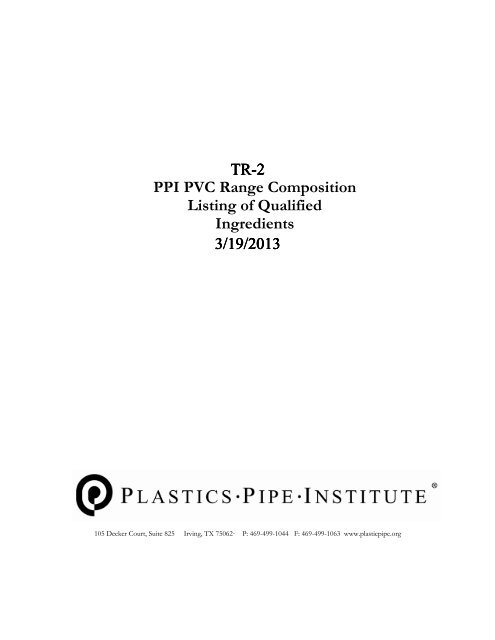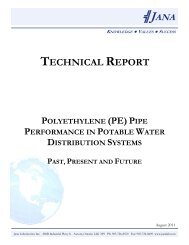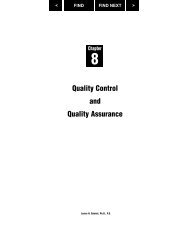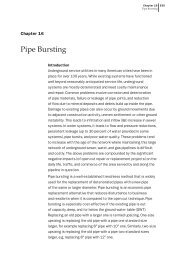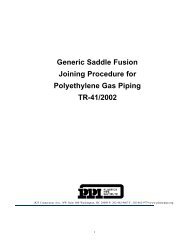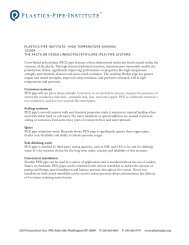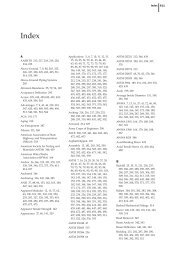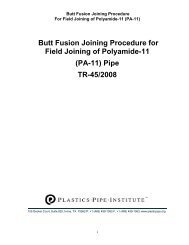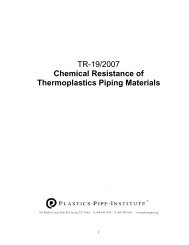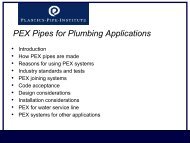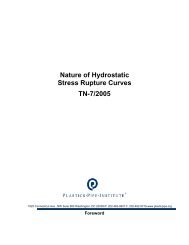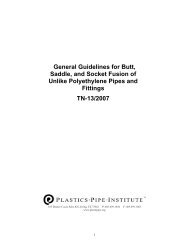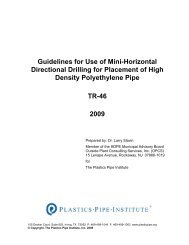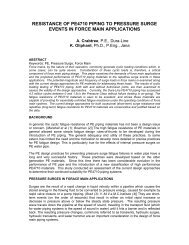TR-2 PPI PVC Range Composition Listing of Qualified Ingredients
TR-2 PPI PVC Range Composition Listing of Qualified Ingredients
TR-2 PPI PVC Range Composition Listing of Qualified Ingredients
Create successful ePaper yourself
Turn your PDF publications into a flip-book with our unique Google optimized e-Paper software.
<strong>TR</strong>-2/2011<br />
<strong>PPI</strong> <strong>PVC</strong> <strong>Range</strong> <strong>Composition</strong><br />
<strong>Listing</strong> <strong>of</strong> <strong>Qualified</strong><br />
<strong>Ingredients</strong><br />
3/19/2013<br />
105 Decker Court, Suite 825 Irving, TX 75062· P: 469-499-1044 F: 469-499-1063 www.plasticpipe.org
Foreword<br />
This technical report was developed and published with the technical help and financial support<br />
<strong>of</strong> the members <strong>of</strong> the <strong>PPI</strong> (Plastics Pipe Institute). The members have shown their interest in<br />
quality products by assisting independent standards-making and user organizations in the<br />
development <strong>of</strong> standards, and also by developing reports on an industry-wide basis to help<br />
engineers, code <strong>of</strong>ficials, specifying groups, and users.<br />
<strong>PPI</strong>’s <strong>PVC</strong> range composition and all applicable policies are included in this technical report.<br />
This technical report lists <strong>of</strong> each <strong>of</strong> the ingredients that have been accepted by the Hydrostatic<br />
Stress Board (HSB) by its commercial designation as qualified for use in <strong>PPI</strong>’s <strong>PVC</strong> <strong>Range</strong><br />
<strong>Composition</strong>. Requirements for acceptance are covered by applicable <strong>PPI</strong> policy or, in cases for<br />
which there is no applicable policy, the HSB may determine these requirements through a<br />
“Special Case” consideration. The listings included in this report also show allowable use levels<br />
for each ingredient and any other applicable limitation.<br />
This report has been prepared by <strong>PPI</strong> as a service <strong>of</strong> the industry. The information in this report<br />
is <strong>of</strong>fered in good faith and believed to be accurate at the time <strong>of</strong> its preparation, but is <strong>of</strong>fered<br />
without any warranty, expressed or implied, including WARRANTIES OF<br />
MERCHANTABILITY AND FITNESS FOR A PARTICULAR PURPOSE. Any reference to<br />
or testing <strong>of</strong> a particular proprietary product should not be construed as an endorsement by <strong>PPI</strong>,<br />
which does not endorse the proprietary products or processes <strong>of</strong> any manufacturer. Industry<br />
members in fulfilling their own compliance responsibilities <strong>of</strong>fer the information in this report<br />
for consideration. <strong>PPI</strong> assumes no responsibility for compliance with applicable laws and<br />
regulations.<br />
<strong>PPI</strong> intends to revise this technical report annually, in response to comments and suggestions<br />
from users <strong>of</strong> the report. Please send suggestions <strong>of</strong> improvements to <strong>PPI</strong>. This report, as well<br />
as other publications, is available for download from <strong>PPI</strong> on the website www.plasticpipe.org.<br />
The Plastics Pipe Institute<br />
www.plasticpipe.org<br />
February 2011 (revised May 2011)
Table <strong>of</strong> Contents<br />
I. Definitions Specific to <strong>TR</strong>-2 2<br />
II. Introduction 4<br />
III. <strong>PPI</strong> <strong>PVC</strong> <strong>Range</strong> <strong>Composition</strong> 6<br />
Part A – Pre-qualified <strong>Ingredients</strong> Exempted from Stress Rupture Testing<br />
A.1 <strong>PVC</strong> Resin 7<br />
A.2 Calcium Stearate 8<br />
A.3 Paraffinic Hydrocarbon Wax 9<br />
A.4 Polyethylene Wax 10<br />
A.5 Titanium Dioxide 11<br />
A.6 Calcium Carbonate 12<br />
Part B – <strong>PVC</strong> Resin, Functionally Equivalent and Other <strong>Ingredients</strong> not Exempted<br />
from Stress-Rupture testing<br />
B.1 <strong>PVC</strong> Resin 14<br />
B.2 Components Not Complying to Part A 15<br />
Part C – Standard Industry Practice <strong>of</strong> High Intensity Mixing <strong>of</strong> <strong>PVC</strong><br />
Pipe Compounds 16<br />
IV. <strong>Listing</strong> <strong>of</strong> Pre-qualified and Functionally Equivalent <strong>Ingredients</strong><br />
Table TABLE 1 1 –– <strong>PVC</strong> Resin RESIN 17<br />
Table TABLE 22 – Heat HEAT Stabilizer STABILIZER 18<br />
Table TABLE 3A 3A – Calcium CALCIUM Stearate STEARATE 20 19<br />
Table TABLE 3B 3B – Calcium CALCIUM Stearate STEARATE Functional FUNCTIONAL Equivalents EQUIVALENT 20 19<br />
Table 4A – Paraffin Wax 21<br />
TABLE 4A – PARAFFIN WAX 20<br />
Table 4B – Paraffin Wax Functional Equivalents 21<br />
Table TABLE 5A 4B – Polyethylene PARAFFIN WAX Wax FUNCTIONAL EQUIVALENT 22 20<br />
Table TABLE 5B 5A – Polyethylene POLYETHYLENE Wax WAX Functional Equivalents 22 21<br />
Table TABLE 6A 5B – Titanium POLYETHYLENE Dioxide WAX FUNCTIONAL EQUIVALENT 23 21<br />
Table TABLE 6B 6A –– Titanium TITANIUM Dioxide DIOXIDE Functional Equivalents – Liquid Dispersed 23 22<br />
Table 6C – Titanium Dioxide Functional Equivalents – Dry Powders 25<br />
TABLE 6B – TITANIUM DIOXIDE FUNCTIONAL EQUIVALENT -- LIQUID DISPERSED 23<br />
Table 7A – Calcium Carbonate 26<br />
Table TABLE 7B 6C –– Calcium TITANIUM Carbonate DIOXIDE Functional FUNCTIONAL Equivalents EQUIVALENT -- DRY POWDERS 26 24<br />
Table TABLE 87A- – Processing CALCIUM CARBONATE Aid 27 24<br />
Table TABLE 9A 7B- – CALCIUM Colorant – CARBONATE Dry Powders FUNCTIONAL EQUIVALENT 28 24<br />
Table TABLE 9B 8 – PROCESSING Colorant – Liquid AID Dispersed 29 25<br />
Table 10 – Combination Ingredient Packages 30<br />
TABLE 9A – COLORANT – DRY POWDER 26<br />
Table 11 – Functionally Equivalent Ingredient Packages 33<br />
TABLE 9B – COLORANT – LIQUID DISPERSED 27<br />
TABLE 10 – COMBINATION INGREDIENT PACKAGE 28<br />
TABLE 11 – FUNCTIONALLY EQUIVALENT INGREDIENT PACKAGE 31<br />
Page 1
Appendix A – Example Letter for Requesting Dependent <strong>Listing</strong> for <strong>PPI</strong> <strong>Range</strong><br />
37<br />
Formulation<br />
Appendix A – Example Letter for Requesting Dependent <strong>Listing</strong> for <strong>PPI</strong> <strong>Range</strong> Formulation<br />
Appendix B – PMD Test Procedures & References for the Evaluation <strong>of</strong> Calcium<br />
39<br />
38<br />
Appendix B – PMD Carbonate Test Procedures & References for the Evaluation <strong>of</strong> Calcium Carbonate 40<br />
Appendix C – Calculation Example to convert <strong>PVC</strong> Compound Formulations from PHR 40<br />
Appendix C – Calculation<br />
to Weight<br />
Example<br />
Percentage<br />
to convert <strong>PVC</strong> Compound Formulations from PHR to 42<br />
Weight Percentage<br />
Appendix D – List <strong>of</strong> Manufacturer Contacts 41<br />
Appendix D – List <strong>of</strong> Manufacturer Contacts<br />
Appendix E – <strong>PPI</strong> Membership<br />
43<br />
44<br />
Appendix E – <strong>PPI</strong> Membership 48<br />
Page 2
I. Definitions Specific to <strong>TR</strong>-2<br />
Vinyl Plastics – <strong>Composition</strong>s <strong>of</strong> polymers and ingredients that are based on polymers <strong>of</strong> vinyl<br />
chloride, or copolymers <strong>of</strong> vinyl chloride with other monomers, the vinyl chloride being in the<br />
greatest amount by mass. Within the context <strong>of</strong> <strong>TR</strong>-2 the term vinyl is limited to compositions<br />
<strong>of</strong> polyvinyl chloride (<strong>PVC</strong>).<br />
Ingredient – Any chemical, mineral, polymer or other ingredient that has been added to a vinyl<br />
composition for the purpose <strong>of</strong> imparting certain desired processing or product performance<br />
properties.<br />
Pre-qualified Ingredient – Any chemical, mineral, polymer, etc. having properties meeting the<br />
applicable requirements as set forth in Section III Part B.<br />
Functionally Equivalent Ingredient – Any chemical, mineral, polymer, etc. not having<br />
properties meeting the applicable requirements as set forth in Section III Part B and shown to<br />
function in an equivalent manner through testing.<br />
Combination Ingredient Package – A set ratio <strong>of</strong> a pre-blended combination <strong>of</strong> prequalified<br />
ingredients. As a service to formulators <strong>of</strong> <strong>PVC</strong> pipe compounders, some<br />
suppliers <strong>of</strong> ingredients make available “packages” <strong>of</strong> pre-blended combinations <strong>of</strong> Prequalified<br />
<strong>Ingredients</strong> provided: 1) each <strong>of</strong> its individual ingredients is qualified for such<br />
use; and 2) the net amount <strong>of</strong> each individual ingredient that is introduced into the<br />
composition, both through the “package” and by direct addition, is in compliance with<br />
the composition requirements for that ingredient. It is the responsibility <strong>of</strong> the<br />
formulator to make sure that the <strong>PPI</strong> <strong>PVC</strong> range composition is always prepared in<br />
accordance with the currently listed composition.<br />
Functional Equivalent Ingredient Package – A set ratio <strong>of</strong> a pre-blended combination<br />
<strong>of</strong> ingredients containing an ingredient/ingredients that is not pre-qualified. This package<br />
will be accepted for listing upon completion <strong>of</strong> testing demonstrating that its use in <strong>PPI</strong>’s<br />
<strong>PVC</strong> <strong>Range</strong> <strong>Composition</strong> continues to yield a <strong>PVC</strong> compound that complies with the<br />
minimum property requirements for cell class 12454, in accordance with ASTM D1784, and<br />
that qualifies for a 4,000 psi HDB, for water, for 73.4°F, in accordance with ASTM D2837.<br />
There is no standard protocol, or policy for effecting this demonstration. Minimum data<br />
requirements are established by the HSB for each case, depending on the nature <strong>of</strong> the<br />
ingredients, and the information already available. Those seeking to qualify these kinds <strong>of</strong><br />
combinations <strong>of</strong> ingredients should make a “Special Case” request <strong>of</strong> the Chairman <strong>of</strong> the<br />
HSB.<br />
<strong>PPI</strong> <strong>PVC</strong> <strong>Range</strong> <strong>Composition</strong> – A <strong>PVC</strong> composition, classified as <strong>PVC</strong> 1120, Class 12454 in<br />
accordance with applicable ASTM requirements, that carries a <strong>PPI</strong> recommended hydrostatic<br />
design basis (HDB) <strong>of</strong> 4,000 psi (27.58 MPa) for water for 73.4°F (23°C), with such basis<br />
having been established in accordance with requirements stated in <strong>PPI</strong> Technical Reports <strong>TR</strong>-2<br />
and <strong>TR</strong>-3. This composition is maintained by the HSB <strong>of</strong> <strong>PPI</strong> and is made available for use by<br />
the general public.<br />
Page 2
Privately held <strong>PVC</strong> <strong>Composition</strong> – A privately held <strong>PVC</strong> composition that carries a <strong>PPI</strong><br />
recommended hydrostatic design basis (HDB) that has been established based on the<br />
requirements <strong>of</strong> <strong>PPI</strong> Technical Reports <strong>TR</strong>-2 and <strong>TR</strong>-3. This private composition is maintained<br />
by a specific company or organization and is not made available by <strong>PPI</strong> to the general public.<br />
Standard Grade (S) - A <strong>PPI</strong> HSB recommended rating that is valid for a five-year period,<br />
given to those materials that comply with the full data requirements <strong>of</strong> <strong>TR</strong>-2 and <strong>TR</strong>-3.<br />
Experimental Grade (E) - A <strong>PPI</strong> HSB recommended rating that is valid for a limited<br />
duration, given to those materials covered by data that do not yet comply with the full<br />
requirements <strong>of</strong> the Standard Grade, but satisfy the applicable minimum preliminary data<br />
requirements that are detailed in <strong>TR</strong>-2 and <strong>TR</strong>-3. The owner <strong>of</strong> an experimental listing must<br />
understand there is a potential risk in commercial sale <strong>of</strong> an experimental ingredient in case it<br />
does not meet all the<strong>TR</strong>-2 requirements.<br />
Page 3
II. Introduction<br />
It was recognized early in the evolution <strong>of</strong> the thermoplastics pipe industry that in consequence<br />
<strong>of</strong> its viscoelastic nature, the fracture strength <strong>of</strong> a thermoplastic polymer is significantly<br />
influenced – for any given set <strong>of</strong> conditions <strong>of</strong> temperature and environment – by duration <strong>of</strong><br />
loading. The longer a load is sustained; the lower is the fracture strength. It was also<br />
recognized that the long-term strength <strong>of</strong> a thermoplastics composition is not only determined<br />
by the primary ingredient, the base polymer, but can also be pr<strong>of</strong>oundly influenced by the<br />
nature and quantity <strong>of</strong> ingredients – such as property modifiers, processing aids, stabilizers, and<br />
colorants – that are used to enhance performance and facilitate processing, and to give product<br />
identification. But in those early days there existed no standard method by which reliable design<br />
stresses could be established for thermoplastic compositions intended for pressure pipe. All<br />
too <strong>of</strong>ten, design stresses were based on results <strong>of</strong> relatively short-term loading with safety factors<br />
that – based on experience, educated guess, limited experience, or other rationale – were said to<br />
adequately compensate for the reduction in long-term strength that characteristically occurs<br />
with all plastics when subjected to prolonged loading. Unfortunately, this approach was not<br />
only inconsistent from material to material, but <strong>of</strong>tentimes it was unreliable. The long-term<br />
strength <strong>of</strong> some materials was overestimated, while that <strong>of</strong> others was underestimated.<br />
To remedy this situation, the Thermoplastics Pipe Division (subsequently named the Plastics<br />
Pipe Institute) <strong>of</strong> the Society <strong>of</strong> the Plastics Industry established in November 1958 the<br />
Working Stress Subcommittee, the predecessor to the Hydrostatic Stress Board (HSB),<br />
consisting <strong>of</strong> technical persons well versed in the state-<strong>of</strong>-the-art <strong>of</strong> the evaluation and forecast<br />
<strong>of</strong> the long-term strength <strong>of</strong> plastics. Two and half years later, in April 1961, this group agreed<br />
on a uniform Tentative Method for Estimating Long-Term Hydrostatic Strength and<br />
Hydrostatic Design Stress <strong>of</strong> Thermoplastic Pipe; and in July 1963, it issued its first hydrostatic<br />
design stress recommendations for compositions for which data had been submitted in<br />
accordance with this method.<br />
A frequent challenge to the HSB was the evolutionary nature <strong>of</strong> the industry, particularly in the<br />
case <strong>of</strong> <strong>PVC</strong> pipe compositions. At first, each <strong>PVC</strong> composition was a fixed and very specific<br />
composition, with the use level and identity <strong>of</strong> each ingredient spelled out. The ingredient<br />
identification would <strong>of</strong>ten consist <strong>of</strong> a manufacturer’s trade designation. In search <strong>of</strong> more<br />
effective and less costly sources <strong>of</strong> ingredients, companies holding listings for <strong>PVC</strong><br />
compositions would <strong>of</strong>ten qualify alternative sources <strong>of</strong> a certain ingredient. To demonstrate<br />
qualification a company had to submit to the HSB extensive long-term data that showed the<br />
proposed change would not compromise a listed composition’s long-term strength. From the<br />
knowledge learned by this work, policies were developed whereby a newly proposed ingredient,<br />
for example, a calcium carbonate – can qualify for that purpose provided it is demonstrated that<br />
its physical and chemical properties comply to requirements that have been established for that<br />
class <strong>of</strong> ingredient based on results <strong>of</strong> industry wide testing. These policies provided for prequalification<br />
<strong>of</strong> ingredients that greatly facilitated the process <strong>of</strong> determining equivalence.<br />
Later on, during the seventies, the concept <strong>of</strong> “<strong>PVC</strong> range compositions” was introduced. As<br />
new and improved extrusion technology began to be used, it was discovered that fine-tuning<br />
the quantity <strong>of</strong> certain ingredients – particularly, so called “internal” and “external” lubricants –<br />
would greatly benefit production rate and product quality. To avoid the impracticality <strong>of</strong><br />
having to qualify each composition variation, industry expanded their fixed content recipes into<br />
range compositions, whereby the allowable content <strong>of</strong> certain ingredients was defined not by a<br />
Page 4
fixed amount but rather, by a minimum/maximum range. The acceptable ranges <strong>of</strong> ingredient<br />
content had also to be established by long-term data documentation.<br />
To make it possible to use resins and other ingredients from different suppliers, extruders <strong>of</strong><br />
<strong>PVC</strong> pipe had to qualify a number <strong>of</strong> “different” range <strong>PVC</strong> compositions – each provided by a<br />
different resin supplier – which in fact were <strong>of</strong>ten times quite the same except for source <strong>of</strong><br />
resin, or some other key ingredient. For a manufacturer <strong>of</strong> a new ingredient, or <strong>of</strong> an<br />
alternative to an existing ingredient, having to qualify his product for inclusion in the many<br />
private <strong>PVC</strong> range compositions that then abounded was a costly and time consuming process.<br />
In recognition <strong>of</strong> this situation, the HSB proposed in 1983 to establish a single, generic and<br />
public <strong>PVC</strong> range composition which then included all <strong>PVC</strong> resins and ingredients which had<br />
been qualified in privately held compositions <strong>of</strong> the same kind. To accomplish this required the<br />
cooperation <strong>of</strong> all major holders <strong>of</strong> <strong>PVC</strong> compositions, including their willingness to share with<br />
the HSB their confidential recipes. This cooperation was obtained, the compositions <strong>of</strong> the<br />
many stress-rated compositions were compared, and a single, generic, state-<strong>of</strong>-the-art<br />
composition was established which allowed a wide choice in <strong>PVC</strong> resins and in ingredients.<br />
The HSB next worked on defining the policies and procedures for qualifying new ingredients.<br />
In 1985 the <strong>PPI</strong> <strong>PVC</strong> range composition and related policies were agreed upon and are<br />
published in this report. Since that time many new alternate ingredients have been qualified for<br />
use in this composition.<br />
The policies and procedures in this Technical Report are intended to cover ingredient listings<br />
for most <strong>PVC</strong> piping applications. <strong>PPI</strong> recognizes there may be unusual cases, issues or<br />
circumstances that are not covered in <strong>TR</strong>-2, and that may justify an exception to the standard<br />
policies. To allow manufacturers an opportunity to have their ingredient(s) listed by <strong>PPI</strong> when<br />
this occurs, the HSB has provided a “Special Case” system. The manufacturer may present its<br />
“Case” to the HSB at one <strong>of</strong> their two annual meetings, usually in February and August, using<br />
the approved “Special Case” form in <strong>TR</strong>-3. All information provided to HSB in these special<br />
cases will be made available for review only by HSB members and <strong>PPI</strong> staff, and will be held by<br />
them in strict confidence, in accordance with <strong>PPI</strong>’s written confidentiality procedures (available<br />
from the HSB Chairman). There is a <strong>PPI</strong> fee for each special case. You must contact the HSB<br />
Chairman well in advance <strong>of</strong> each meeting to arrange for your special case. A completed HSB<br />
submission form must be received at least two (2) weeks prior to the HSB meeting to permit<br />
HSB consideration at that meeting.<br />
Page 5
III. <strong>PPI</strong> <strong>PVC</strong> <strong>Range</strong> <strong>Composition</strong><br />
The HSB has classified all ingredients in the <strong>PPI</strong> <strong>PVC</strong> range composition into four classes. Two<br />
classes cover pre-qualified ingredients (Part A) and the other two cover functional<br />
equivalents (Part B), as follows:<br />
• <strong>Ingredients</strong> that are pre-qualified for use in <strong>PPI</strong>’s <strong>PVC</strong> <strong>Range</strong> <strong>Composition</strong> by<br />
the demonstration <strong>of</strong> the ingredient’s compliance to chemical and physical<br />
property requirements <strong>of</strong> the applicable HSB policy;<br />
• Packages (blends) <strong>of</strong> pre-qualified ingredients;<br />
• <strong>Ingredients</strong> that although not meeting applicable pre-qualification requirements<br />
for that class <strong>of</strong> ingredient they exhibit an equivalent function;<br />
• Packages (blends) <strong>of</strong> qualified ingredients, one or more <strong>of</strong> which is a functional<br />
equivalent to a pre-qualified ingredient.<br />
In its continuing commitment to provide effective service to the industry, this <strong>TR</strong>-2 lists<br />
qualified ingredients in accordance with the above classification system.<br />
Because the <strong>PPI</strong> <strong>PVC</strong> <strong>Range</strong> <strong>Composition</strong> has been established from a matrix <strong>of</strong> <strong>PPI</strong> listed range<br />
compositions – each <strong>of</strong> which has a 4,000 psi hydrostatic design basis at 73.4 ° F that has been<br />
established through extensive stress-rupture testing – a company may obtain a dependent listing<br />
under this composition without having to submit any additional stress-rupture data. However, a<br />
company obtaining a dependent listing under <strong>PPI</strong>’s <strong>PVC</strong> <strong>Range</strong> <strong>Composition</strong> must agree to<br />
formulate, and only use the materials as prescribed by Part A. Information on how a dependent<br />
listing may be obtained is given in Appendix A.<br />
Part A. Pre-qualified <strong>Ingredients</strong> Exempted From Stress-Rupture Testing<br />
An individual or combination ingredient that meets the allowable content range in Table 1 and the<br />
physical property requirements <strong>of</strong> Part A is a pre-qualified ingredient and is exempt from stress<br />
rupture testing for qualification. An ingredient manufacturer may still elect to publish this prequalified<br />
ingredient in the appropriate table in <strong>TR</strong>-2.<br />
A <strong>PVC</strong> composition that complies with the minimum property requirements <strong>of</strong> cell class 12454<br />
according to ASTM D 1784 and that satisfies the limitations <strong>of</strong> the <strong>PVC</strong> range formulation given<br />
in Table I, qualifies for a recommended hydrostatic design basis (HDB) <strong>of</strong> 4,000 psi at 73 o F<br />
(23 o C) without the need to submit the stress-rupture data. A manufacturer wishing to register this<br />
<strong>PVC</strong> range composition for use in his plant should apply to the Chairman <strong>of</strong> <strong>PPI</strong>'s HSB and<br />
identify the manufacturer's commercial designation for this composition. These <strong>PVC</strong><br />
compositions are dependent on the <strong>PPI</strong> <strong>PVC</strong> range composition and are published in <strong>PPI</strong> <strong>TR</strong>-4.<br />
Page 6
TABLE I<br />
<strong>PPI</strong> <strong>PVC</strong> RANGE COMPOSITION FOR LISTING AT 73 o F (23 o C)<br />
Ingredient Qualification Requirements<br />
Allowable Content <strong>Range</strong><br />
(in parts per<br />
hundred parts <strong>of</strong> resin)<br />
<strong>PVC</strong> Resin<br />
Compliance to B.1 and <strong>Listing</strong><br />
100<br />
by <strong>PPI</strong><br />
Heat Stabilizer Compliance to B.2 and <strong>Listing</strong><br />
0.3 - 1.0<br />
by <strong>PPI</strong><br />
Calcium Stearate Compliance to A.2 0.4 - 1.5<br />
Paraffin Wax Compliance to A.3 0.6 -1.5<br />
Polyethylene Wax Compliance to A.4 0.0 - 0.3<br />
Titanium Dioxide Compliance to A.5 0.5 - 3.0<br />
Calcium Carbonate Compliance to A.6 0.0 - 5.0<br />
Process Aid<br />
Compliance to B.2 and <strong>Listing</strong><br />
0.0 -2.0<br />
by <strong>PPI</strong><br />
Colorant<br />
Compliance to B.2 and <strong>Listing</strong><br />
by <strong>PPI</strong>, or compliance to<br />
See Table 9<br />
Combination and<br />
Functional Equivalent<br />
<strong>TR</strong>-3 Part D.1<br />
<strong>Listing</strong> By <strong>PPI</strong><br />
NOTE: See <strong>TR</strong>-2, Section IV for listing <strong>of</strong> Prequalified and Functionally Equivalent <strong>Ingredients</strong><br />
The pipe manufacturer is encouraged to perform some stress-rupture testing on any combination<br />
<strong>of</strong> ingredients that is new to him to ensure that the anticipated strength is realized under the<br />
selected processing conditions. One <strong>of</strong> the best means to check for proper processing is by use <strong>of</strong><br />
either the Accelerated Regression Test (ASTM D 2241) or other long-term stress-rupture data<br />
generated in accordance with ASTM D 1598 and analyzed by the method <strong>of</strong> least squares as<br />
described in ASTM D 2837.<br />
Part A.1 <strong>PVC</strong> Resin<br />
This policy only applies to suspension grades <strong>of</strong> <strong>PVC</strong> resins.<br />
There are no pre-qualified <strong>PVC</strong> resins for the <strong>PPI</strong> <strong>PVC</strong> Generic <strong>Range</strong> Formulation. All <strong>PVC</strong><br />
resins must be qualified according to Part B.<br />
<strong>PVC</strong> Resin made in a new plant – For equivalent <strong>PVC</strong> resin that is currently listed in <strong>TR</strong>-2 that is<br />
made in a new plant, a provisional listing will be granted based on manufacturer’s data supporting<br />
equality <strong>of</strong> the resin through chemical and physical property analysis. E-2 level hydrostatic data is<br />
required for a standard grade listing.<br />
Page 7
Part A.2<br />
Calcium Stearate<br />
The following guidelines are not to be considered as specifications or standards to indicate the<br />
requirements for calcium stearates, nor is it intended that they describe all the commercial<br />
calcium stearates that are suitable for use in polyvinyl chloride (<strong>PVC</strong>) plastic pipe compounds.<br />
The intent is only to give guidelines for alternative use <strong>of</strong> members <strong>of</strong> a group <strong>of</strong> commercial<br />
calcium stearates that are apparently chemically identical and that have been found by physiochemical<br />
analysis, by engineering pipe testing, and by use <strong>of</strong> pipe in the field to be sufficiently<br />
similar in nature to produce pipe and fittings that are basically the same in properties and<br />
performance. Consideration has been given to physio-chemical analysis <strong>of</strong> the calcium<br />
stearates, long-term hydrostatic pressure testing <strong>of</strong> pipe, and requirements <strong>of</strong> the applicable<br />
pipe standards.<br />
Commercial calcium stearates may be substituted one for another in polyvinyl chloride (<strong>PVC</strong>)<br />
plastic pipe and fitting compounds without additional long-term pipe testing provided (1) the<br />
substitution is for the same amount, (2) the substitution in the compound is 1.5 parts or less per<br />
hundred parts <strong>of</strong> resin and (3) the properties fall within the ranges given below:<br />
Property (See Note 1)<br />
Requirements<br />
Melting Point, °F (°C) 293-329 (145-165)<br />
Chlorides, as chloride ion, %, max 0.3<br />
Free fatty acid, %, max 1.0<br />
Acid number (See Note 2) 200 +/- 15<br />
Iodine value, max (See Note 2) 5.0<br />
Volatile content, at 221 °F (105 °C), %, max 3.5<br />
Ash, as CaO, at 1832 °F (1000 °C) 9.00 – 12.0<br />
Iron, ppm, max 100<br />
Color<br />
Particle Size<br />
White to <strong>of</strong>f-white<br />
At least 95% through U.S.<br />
Standard 20 mesh<br />
NOTE 1:<br />
NOTE 2:<br />
The test methods shall be those commonly used in the calcium stearate industry.<br />
Acid number and iodine value apply to the stearic acid raw material.<br />
Calcium stearates not meeting these guidelines may be evaluated as a functional equivalent in<br />
accordance with the policies and procedures in Part B <strong>of</strong> <strong>TR</strong>-2. When sufficient data,<br />
background, and successful usage, both in production and service, have been developed with<br />
other calcium stearates, they may be considered for inclusion in a new group under these<br />
guidelines.<br />
Page 8
Part A.3 Paraffinic Hydrocarbon Wax<br />
The following guidelines are not to be considered as specifications or standards to indicate the<br />
requirements for hydrocarbon waxes, nor is it intended that they describe all the commercial<br />
hydrocarbon waxes that are suitable for use in polyvinyl chloride plastic (<strong>PVC</strong>) pipe compounds.<br />
The intent is only to give guidelines for the alternate use <strong>of</strong> members <strong>of</strong> a group <strong>of</strong> commercial<br />
paraffinic hydrocarbon waxes that have been found by physio-chemical analysis, by engineering<br />
pipe testing, and by use <strong>of</strong> pipe in the field to be sufficiently similar in properties and<br />
performance. Consideration has been given to physio-chemical analysis <strong>of</strong> the hydrocarbon<br />
waxes, long-term hydrostatic pressure testing <strong>of</strong> pipe, and requirements <strong>of</strong> the applicable<br />
standards (See Note 1).<br />
Commercial paraffinic hydrocarbon waxes may be substituted one for another in polyvinyl<br />
chloride (<strong>PVC</strong>) plastic pipe and fitting compounds without additional long-term pipe testing<br />
provided (1) the substitution is for the same amount, (2) the substitution in the compound is 1.5<br />
parts or less per hundred parts <strong>of</strong> resin, (3) the particle size is approximately the same and (4) the<br />
properties fall within the ranges given below:<br />
PROPERTY TEST METHOD REQUIREMENT<br />
(See Note 2)<br />
Chemical Type<br />
*Hydrocarbon wax<br />
Congealing Point,°F (°C) ASTM D938 149 – 169 (65 – 76)<br />
Viscosity at 210 °F ASTM D445 5.5 – 7.5 cSt<br />
Kinematic Carbon Number ASTM D5442 Min 80% C26 – C50<br />
Distribution <strong>of</strong><br />
Part A.4<br />
Polyethylene Wax<br />
The following guidelines are not to be considered as specifications or standards to indicate the<br />
requirements for polyethylene waxes, nor is it intended that they describe all the commercial<br />
polyethylene waxes that are suitable for use in polyvinyl chloride (<strong>PVC</strong>) plastic pipe compounds.<br />
The intent is only to give guidelines for alternative use <strong>of</strong> members <strong>of</strong> a group <strong>of</strong> commercial<br />
polyethylene waxes that are apparently identical and that have been found by physio-chemical<br />
analysis, by engineering pipe testing, and by the use <strong>of</strong> pipe in the field to be sufficiently similar in<br />
nature to produce pipe and fittings that are basically the same in properties and performance.<br />
Consideration has been given to physio-chemical analysis <strong>of</strong> the polyethylene waxes, long-term<br />
hydrostatic pressure testing <strong>of</strong> pipe, and requirements <strong>of</strong> the applicable standards (See Note 1).<br />
Commercial polyethylene waxes may be substituted one for another in polyvinyl chloride (<strong>PVC</strong>)<br />
plastic pipe and fitting compounds without additional long-term pipe testing provided (1) the<br />
substitution is for the same amount, (2) the substitution in the compound is 0.3 parts or less per<br />
hundred parts <strong>of</strong> resin and (3) the properties fall within the ranges given below:<br />
PROPERTY<br />
ASTM TEST REQUIREMENT<br />
METHOD<br />
Gardner Color (Molten Wax) D-1544 4 max<br />
Flash point, minimum o F ( o C) D-92 500 (260) open cup<br />
425 (218) closed cup<br />
Ring and Ball S<strong>of</strong>tening Point, o F ( o C)<br />
Or<br />
Mettler Drop Point Test, o F ( o C)<br />
E-28<br />
D3954<br />
210 - 225 (99 - 107)<br />
203 – 221 (95 – 105)<br />
Thermosel Viscosity @ 283 o F (140 o C) cp D-3236 70 - 400<br />
Penetration Hardness D-5 3 - 6<br />
Acid Number, mg KOH/g (1) 10 - 18<br />
(1) The test method may be any that is commonly used by the industry such as Allied<br />
Chemical W-305-TW-1 or Eastman Chemical ECD 27-102.<br />
NOTE 1:<br />
Polyethylene waxes not meeting these guidelines may be evaluated as a functional<br />
equivalent in accordance with the policies and procedures in Part B <strong>of</strong> <strong>TR</strong>-2. When<br />
sufficient data, background, and successful usage, both in production and service,<br />
have been developed with other polyethylene waxes, they may be considered for<br />
inclusion in a new group under these guidelines.<br />
Page 10
Part A.5<br />
Titanium Dioxide<br />
The following guidelines are not to be considered as specifications or standards to indicate the<br />
requirements for titanium dioxides, nor is it intended that they describe all the commercial<br />
titanium dioxides that are suitable for use in polyvinyl chloride (<strong>PVC</strong>) plastic pipe compounds.<br />
The intent is only to give guidelines for alternative use <strong>of</strong> members <strong>of</strong> a group <strong>of</strong> commercial<br />
titanium dioxides that are apparently chemically identical and that have been found by<br />
physiochemical analysis, by engineering pipe testing, and by use <strong>of</strong> pipe in the field, to be<br />
sufficiently similar in nature to produce pipe and fittings that are basically the same in properties<br />
and performance. Consideration has been given to physiochemical analysis <strong>of</strong> the titanium<br />
dioxides, long-term hydrostatic pressure testing <strong>of</strong> pipe, and requirements <strong>of</strong> the applicable pipe<br />
standards. (See Note 1)<br />
Commercial titanium dioxides may be substituted one for another in polyvinyl chloride (<strong>PVC</strong>)<br />
plastic pipe and fitting compounds without additional long-term pipe testing provided (1) the<br />
substitution is for the same amount, (2) the substitution in the compound is three parts or less per<br />
hundred parts <strong>of</strong> resin, and (3) they meet the following requirements:<br />
Property (See Note 2):<br />
Crystal structure<br />
Rutile<br />
Particle size<br />
Average, microns 0.10 - 0.35<br />
Retained on 325 mesh screen, %, max 0.20<br />
Titanium dioxide content, %, min 92.00<br />
Chemical modification<br />
alumina and/or silica<br />
Carbon content, at 1652 °F (900 °C), %, max 0.30<br />
(burn and measure carbon dioxide)<br />
Volatile content loss at 221 °F (105 °C), %, max 0.70<br />
Specific gravity 4.0 - 4.3<br />
NOTE 1:<br />
NOTE 2:<br />
Titanium dioxides not meeting these guidelines may be evaluated as a functional<br />
equivalent in accordance with the policies and procedures in Part B <strong>of</strong> <strong>TR</strong>-2.<br />
When sufficient data, background and successful usage, both in production and<br />
service, have been developed with other titanium dioxides, they may be<br />
considered for inclusion in a new group under these guidelines.<br />
The test methods shall be those described in ASTM D 476, "Standard<br />
Specification for Titanium Dioxide Pigments.”<br />
Page 11
Part A.6<br />
Calcium Carbonate<br />
The following guidelines are not to be considered as specifications or standards to indicate the<br />
requirements for calcium carbonate, nor is it intended that they describe all the commercial<br />
calcium carbonates that are suitable for use in polyvinyl chloride (<strong>PVC</strong>) plastic pipe and fitting<br />
compounds. The intent is only to give guidelines for the alternative use <strong>of</strong> members <strong>of</strong> two<br />
groups <strong>of</strong> commercial calcium carbonates that are apparently chemically identical (within each<br />
group) and that have been found by physio-chemical analysis, by engineering pipe testing, and by<br />
use <strong>of</strong> pipe in the field to be sufficiently similar (within each group) in nature to produce pipe and<br />
fittings that are basically the same in properties and performance. Consideration has been given<br />
to physio-chemical analysis <strong>of</strong> the calcium carbonates, long-term hydrostatic pressure testing <strong>of</strong><br />
pipe, and requirements <strong>of</strong> the applicable pipe standards.<br />
These guidelines cover two separate groups <strong>of</strong> calcium carbonates, Group A in which the particles<br />
are not coated with another material and Group B in which the particles are coated with<br />
commercial calcium stearate and/or stearic acid. Substitutions may be made within a group but<br />
not from one group to the other (See Note 1).<br />
Group A (uncoated particles)<br />
Uncoated commercial calcium carbonates may be substituted one for another in polyvinyl<br />
chloride (<strong>PVC</strong>) plastic pipe and fitting compounds without additional long-term testing provided<br />
(1) the substitution is for the same amount, (2) the amount used in the compound is five parts or<br />
less per hundred parts <strong>of</strong> resin, and (3) the properties fall within the ranges given below:<br />
PROPERTY (PMD Test Methods – See Appendix B)<br />
General Description<br />
Chemical analysis<br />
Particle properties<br />
Other properties<br />
REQUIREMENT<br />
Calcium carbonate<br />
(Uncoated particles)<br />
Calcium carbonate analysis, min 94.00%<br />
Iron, as ferric oxide, max 0.25%<br />
Silica, SiO 2 , max. 1.25%<br />
Weight loss at 221 °F (105 °C), max 0.50%<br />
Type<br />
Microcrystalline<br />
Size, micron, range 0.02 - 15.00<br />
Size, micron, mean 0.05 - 3.50<br />
Density, g/cm 3 2.65 - 2.71<br />
Group B (Stearate coated)<br />
Stearate coated commercial calcium carbonates may be substituted one for another in polyvinyl<br />
chloride (<strong>PVC</strong>) plastic pipe and fitting compounds without additional long-term pipe testing<br />
provided (1) the substitution is for the same amount, (2) the amount used in the compound is five<br />
parts or less per hundred <strong>of</strong> resin, and (3) the properties fall within the ranges given below:<br />
Page 12
PROPERTY (PMD Test Methods)<br />
General Description<br />
Chemical analysis<br />
Particle properties<br />
Other properties<br />
REQUIREMENT<br />
Calcium carbonate coated<br />
with calcium stearate (a)<br />
Calcium carbonate analysis, min 93.00%<br />
Iron, as ferric oxide, max 0.25%<br />
Silica, SiO 2 , max. 1.25%<br />
Weight loss at 221 o F (105 o C), max 0.50%<br />
Fatty acids, as stearic acid 0.75 - 2.00<br />
Type<br />
Microcrystalline<br />
Size, micron, range 0.02 - 15.00<br />
Size, micron, mean 0.05 - 3.50<br />
Density, g/cm 3 2.65 - 2.71<br />
(a)<br />
NOTE 1:<br />
This group covers commercial calcium carbonates in which the<br />
particles are coated with commercial grades <strong>of</strong> calcium stearate and/or<br />
stearic acid. The fatty acid mixtures in these stearates are over 50<br />
percent by weight stearic acid (C18) with other fatty acids, mainly<br />
palmitic (C16) and a small amount <strong>of</strong> myristic (C14).<br />
Calcium carbonates not meeting either <strong>of</strong> these two groups <strong>of</strong> guidelines<br />
may be evaluated as a functional equivalent in accordance the policies and<br />
procedures in Part B <strong>of</strong> <strong>TR</strong>-2. When sufficient data, background, and<br />
successful usage both in production and service have been developed with<br />
other calcium carbonates, they may be considered for inclusion in a new<br />
group under these guidelines.<br />
Page 13
Part B.<br />
<strong>PVC</strong> Resin, Functionally Equivalent and Other <strong>Ingredients</strong> Not<br />
Exempted From Stress-Rupture Testing - Data Requirements<br />
for <strong>Listing</strong> at 73 o F (23 o C)<br />
An individual or combination ingredient that does not meet the allowable content range in Table 1<br />
or the physical property requirements <strong>of</strong> Part A is a functionally equivalent ingredient and is not<br />
exempt from stress rupture testing. All functionally equivalent ingredients are published in the<br />
appropriate tables in <strong>TR</strong>-2.<br />
The principal consideration in the establishment <strong>of</strong> policies and rulings regarding the<br />
determination <strong>of</strong> equivalence <strong>of</strong> a commercially <strong>of</strong>fered ingredient for its use in <strong>PPI</strong>’s <strong>PVC</strong><br />
<strong>Range</strong> <strong>Composition</strong> is the potential adverse effect that the subject ingredient can have on the<br />
short-term and the long-term properties <strong>of</strong> the resultant composition. This composition must<br />
always be formulated so that it is in compliance with the ASTM requirements for <strong>PVC</strong> 1120<br />
materials, Class 12454 as per ASTM D 1784. A particular concern <strong>of</strong> the HSB is that the longterm<br />
hydrostatic strength <strong>of</strong> this composition should always satisfy the ASTM requirements for<br />
a hydrostatic design basis (HDB) <strong>of</strong> 4,000 psi (27.58 MPa) for water at 73.4°F (23°C). It is not<br />
the HSB’s role to consider the effect <strong>of</strong> the use <strong>of</strong> an alternate ingredient on the quality <strong>of</strong> the<br />
fluid that may be transported by the piping made from <strong>PPI</strong>’s <strong>PVC</strong> <strong>Range</strong> <strong>Composition</strong>. This<br />
consideration is left to others. In the case <strong>of</strong> the transport <strong>of</strong> potable water the most<br />
commonly referenced standards that address this issue are NSF/ANSI Standard 14, “Plastics<br />
Piping Systems components and Related Materials”, and NSF/ANSI Standard 61, “Drinking<br />
Water System Components – Health Effects”. Agencies, such as NSF International, have<br />
established programs by which plastic piping compositions, including each <strong>of</strong> the composition’s<br />
ingredients, are evaluated in accordance with these standards and listed when found acceptable.<br />
Because <strong>of</strong> their additional health effects criteria, some <strong>of</strong> the ingredients listed in this report<br />
may not be included in listing issued by these certifying agencies. Agencies certifying<br />
compliance to the above listed NSF/ANSI standards should be contacted for the specifics<br />
relating their listing programs.<br />
This policy is intended only to apply to the <strong>PPI</strong> <strong>Range</strong> <strong>Composition</strong>, with alternative formulation<br />
components that have been determined to be satisfactory for the commercial production <strong>of</strong> <strong>PVC</strong><br />
pressure pipe yielding a 4,000-psi HDB for water at 73 o F (23 o C). The requirements given herein<br />
are not to be considered as specifications or standards that describe the only <strong>PVC</strong> range<br />
formulation and components suitable for production <strong>of</strong> <strong>PVC</strong> 1120 or <strong>PVC</strong> 1220 pipe.<br />
Part B.1 <strong>PVC</strong> Resin<br />
This policy only applies to suspension grades <strong>of</strong> <strong>PVC</strong> resins.<br />
1. The <strong>PVC</strong> resin must meet the property requirements given below:<br />
PROPERTY TEST METHOD REQUIREMENT<br />
Type <strong>of</strong> Material ------ <strong>PVC</strong> Homopolymer<br />
Inherent Viscosity ASTM D1243 0.88 - 0.96<br />
Heat Loss (water); % by weight 1 Hr @ 221 o F (105 o C) 0.5 max<br />
Apparent Bulk Density, gm/cc ASTM D1895 0.46 - 0.62<br />
Compacted Bulk Density, gm/cc ------ 0.54 - 0.72<br />
RVCM ------ 10 ppm max<br />
Page 14
2. Stress-rupture data obtained on pipe extruded on commercial equipment from a <strong>PVC</strong><br />
composition with components falling within the ranges given in Part A, except for liquid stabilizer<br />
and calcium carbonate which must be at the maximum levels, confirm that the use <strong>of</strong> the alternate<br />
<strong>PVC</strong> resin yields the anticipated HDB <strong>of</strong> 4,000 psi for water for 73 o F (23 o C). The data must be<br />
obtained in accordance with <strong>TR</strong>-3 and evaluated according to ASTM D 2837.<br />
a. Experimental listing <strong>of</strong> a new <strong>PVC</strong> resin shall be available upon the presentation <strong>of</strong> acceptable<br />
E-2 or higher-grade data for one lot <strong>of</strong> pipe. The experimental listing expires one year<br />
following the effective date. The owner <strong>of</strong> an experimental listing must understand<br />
there is a potential risk in commercial sale <strong>of</strong> an experimental ingredient in case it<br />
does not meet all the<strong>TR</strong>-2 requirements.<br />
b. Standard listing, with no expiration date, shall be available upon the presentation <strong>of</strong> acceptable<br />
E-10, or higher-grade data for one lot and E-2, or higher-grade data on two other lots.<br />
Part B.2 Heat Stabilizer, Process Aid, Colorant and other Components Not<br />
Complying to Part A<br />
Any heat stabilizer, process aid, or colorant and any calcium stearate, paraffin wax,<br />
polyethylene wax, titanium dioxide or other ingredient not meeting the guidelines given in<br />
Part A will be accepted for listing when the appropriate stress-rupture data confirm the<br />
anticipated HDB <strong>of</strong> 4,000 psi for water at 73°F (23°C) when evaluated according to ASTM<br />
D 2837. The data shall be obtained on pipe extruded on commercial equipment and from<br />
a composition that falls within the ranges listed in Part A except for the subject component<br />
that shall be at the maximum proposed use level. In cases where the minimum proposed<br />
use level is greater than zero, the composition shall be formulated in two lots with the<br />
subject component at the maximum proposed use level and with the subject component at<br />
the minimum proposed use level. The data must be obtained in accordance with <strong>TR</strong>-3 and<br />
evaluated according to ASTM D 2837.<br />
a. Experimental listing <strong>of</strong> the component shall be available upon the presentation <strong>of</strong><br />
acceptable E-2 or higher-level data for one lot <strong>of</strong> pipe that has been formulated with<br />
the subject component at the maximum proposed use level. The experimental<br />
listing expires one year following its effective date. The owner <strong>of</strong> an experimental<br />
listing must understand there is a potential risk in commercial sale <strong>of</strong> an<br />
experimental ingredient in case it does not meet all the <strong>TR</strong>-2 requirements.<br />
b. Standard listing, with no expiration date, shall be available upon the presentation <strong>of</strong><br />
acceptable E-10 or higher-grade data for one lot and E-2 or higher-grade level data<br />
for two other lots. One <strong>of</strong> these lots <strong>of</strong> pipe shall include the subject component at<br />
the minimum proposed use level as required per the above paragraph. Each <strong>of</strong><br />
these three lots shall be formulated with different qualified <strong>PVC</strong> resin.<br />
Page 15
Part C. Standard Industry Practice <strong>of</strong> High Intensity Mixing <strong>of</strong> <strong>PVC</strong> Pipe<br />
Compounds<br />
It is recognized that the method <strong>of</strong> mixing affects dispersion <strong>of</strong> ingredients in compounds and<br />
potentially the quality <strong>of</strong> pipe. Therefore, when qualifying new chemically equivalent ingredients<br />
to the current <strong>PPI</strong> <strong>Range</strong> Formula the method <strong>of</strong> mixing is to be described.<br />
Part E.1 <strong>of</strong> <strong>TR</strong>-3 describes the standard industry practice <strong>of</strong> high intensity mixing <strong>of</strong> <strong>PVC</strong> pipe<br />
compounds.<br />
Page 16
TABLE 1 – <strong>PVC</strong> RESIN<br />
Ingredient Class Qualification Requirement Allowable Use Level (Phr)<br />
<strong>PVC</strong> Resin <strong>Listing</strong> by <strong>PPI</strong> or compliance 100.0 to Section III Part A.1 100.0<br />
<strong>PVC</strong> Resin<br />
Manufacturer Product Limitations <strong>Range</strong>, phr<br />
Braskem S.A. NORVIC SP 767RA PROCESSA+ 100.00<br />
CertainTeed Corporation Certavin CT-1110 100.00<br />
Formosa Plastics Corp. Formolon 622 100.00<br />
Formosa Plastics Corp. Formolon 622F 100.00<br />
Formosa Plastics Corp. Formolon S-65 100.00<br />
Georgia Gulf Chemicals Georgia Gulf 1091 100.00<br />
Georgia Gulf Chemicals Georgia Gulf 5385 100.00<br />
LG Chem LS100 100.00<br />
Mexichem Resinas Columbia SA <strong>PVC</strong>-440 100.00<br />
Mexichem Resinas Vinilicas, SA de CV VINYCEL 103 EPF-76 100.00<br />
Oxy Vinyls, LP OxyVinyls 225 100.00<br />
Oxy Vinyls, LP OxyVinyls 225 G 100.00<br />
Oxy Vinyls, LP OxyVinyls 225 P 100.00<br />
Reliance Industries Ltd. Reon K67-01 100.00<br />
Shintech, Inc. S6704 100.00<br />
Shintech, Inc. SE1100 100.00<br />
Shintech, Inc. SE-950 100.00<br />
Shintech, Inc. SE-950EG 100.00<br />
Shintech, Inc. SE-950W 100.00<br />
Shintech, Inc. TK-1000 100.00<br />
Solvin S.A. 266 RC 100.00<br />
Solvin S.A. 267 RC 100.00<br />
Westlake <strong>PVC</strong> Corporation Westlake 1230P_K 100.00<br />
* Denotes experimental or provisional listing<br />
NOTE 1:<br />
Page 17
TABLE 2 – HEAT STABILIZER<br />
Ingredient Class Qualification Requirement Allowable Use Level (Phr)<br />
Heat Stabilizer <strong>Listing</strong> by <strong>PPI</strong> 0.3 - 1.0 (unless otherwise stated)<br />
Heat Stabilizer<br />
Manufacturer Product Limitations <strong>Range</strong>, phr<br />
Akcros Chemicals Interstab T-5277 0.30 - 1.00<br />
Galata Chemicals Mark 1925 0.30 - 1.00<br />
Galata Chemicals Mark 1928 0.30 - 1.00<br />
Galata Chemicals Mark 1930 0.30 - 1.00<br />
Galata Chemicals Mark 1939 0.30 - 1.00<br />
Galata Chemicals Mark 1939-RLD 0.30 - 1.00<br />
Galata Chemicals Mark 1941 0.30 - 1.00<br />
Galata Chemicals Mark 1971 0.30 - 1.00<br />
Galata Chemicals Mark 2903 0.30 - 1.00<br />
PMC Organometallix, Inc. Advastab NEO 4004* Expires 12/31/2013 0.35 - 0.65<br />
PMC Organometallix, Inc. Advastab TM-283SP 0.30 - 1.00<br />
PMC Organometallix, Inc. Advastab TM-3412 0.30 - 1.00<br />
PMC Organometallix, Inc. Advastab TM-691 0.30 - 1.00<br />
PMC Organometallix, Inc. Advastab TM-694 0.30 - 1.00<br />
PMC Organometallix, Inc. Advastab TM-694-OM 0.30 - 1.00<br />
PMC Organometallix, Inc. Advastab TM-696 0.30 - 1.00<br />
PMC Organometallix, Inc. Advastab TM-697 0.20 - 1.00<br />
PMC Organometallix, Inc. Advastab TM-697-OM 0.20 - 1.00<br />
PMC Organometallix, Inc. Advastab TM-698 0.30 - 1.00<br />
PMC Organometallix, Inc. Advastab TM-900F 0.30 - 1.00<br />
PMC Organometallix, Inc. DM-9924 0.30 - 1.00<br />
PMC Organometallix, Inc. PA-1121 0.30 - 1.00<br />
PMC Organometallix, Inc. PA-2410B 0.30 - 1.00<br />
PMC Organometallix, Inc. PA-4062 0.30 - 1.00<br />
PMC Organometallix, Inc. Thermolite 121 0.30 - 1.00<br />
PMC Organometallix, Inc. Thermolite 130 0.30 - 1.00<br />
PMC Organometallix, Inc. Thermolite 135 0.30 - 1.00<br />
PMC Organometallix, Inc. Thermolite 140 0.30 - 1.00<br />
PMC Organometallix, Inc. Thermolite 150 0.30 - 0.40<br />
PMC Organometallix, Inc. Thermolite 161 0.30 - 1.00<br />
PMC Organometallix, Inc. Thermolite 170 0.30 - 0.50<br />
PMC Organometallix, Inc. Thermolite 176 0.30 - 1.00<br />
PMC Organometallix, Inc. Thermolite 176C 0.30 - 1.00<br />
PMC Organometallix, Inc. Thermolite 178 0.30 - 1.00<br />
PMC Organometallix, Inc. Thermolite 197 0.30 - 1.00<br />
Reagens USA RT-6610 0.30 - 1.00<br />
Reagens USA RT-6611 0.30 - 1.00<br />
Reagens USA RT-6611A 0.30 - 1.00<br />
Reagens USA RT-6611S 0.30 - 1.00<br />
Reagens USA RT-6612 0.30 - 1.00<br />
* Denotes experimental or provisional listing<br />
Page 18
NOTE 1:ADVERA 401 PS or ADVERA 401 F are co-stabilizers and must be used in conjunction with other approved tin<br />
stabilizers. The maximum amount <strong>of</strong> ADVERA 401 PS is 30% and 70% tin stabilizer. The maximum amount <strong>of</strong><br />
ADVERA 401 F is 40% and 60% tin stabilizer. The total combined loading <strong>of</strong> the stabilizer and co-stabilizer must not<br />
exceed 1.0 phr, but must meet minimum stabilizer levels.<br />
Page 19
TABLE 3A – CALCIUM STEARATE<br />
Note – Tables <strong>of</strong> Prequalified <strong>Ingredients</strong> contain products commonly used by industry. Calcium stearates in compliance<br />
with Section III Part A.2 need not appear on this table to be used in the <strong>PPI</strong> <strong>Range</strong> <strong>Composition</strong>.<br />
Ingredient Class Qualification Requirement Allowable Use Level (Phr)<br />
Calcium Stearate Compliance to Section III Part A.2 0.4 - 1.5<br />
Calcium Stearate<br />
Manufacturer Product Limitations <strong>Range</strong>, phr<br />
Dover Chemical Corporation Doverlube CA-20 0.40 - 1.50<br />
Dover Chemical Corporation Doverlube CA-21 0.40 - 1.50<br />
Dover Chemical Corporation Doverlube CA-22 0.40 - 1.50<br />
* Denotes experimental or provisional listing<br />
TABLE 3B – CALCIUM STEARATE FUNCTIONAL EQUIVALENT<br />
Note – Cannot be used with other functional equivalents.<br />
Calcium Stearate Functional Equivalent<br />
Manufacturer Product Limitations <strong>Range</strong>, phr<br />
* Denotes experimental or provisional listing<br />
Page 20
TABLE 4A – PARAFFIN WAX<br />
Note – Tables <strong>of</strong> Prequalified <strong>Ingredients</strong> contain products commonly used by industry. Paraffin waxes in compliance<br />
with Section III Part A.3 need not appear on this table to be used in the <strong>PPI</strong> <strong>Range</strong> <strong>Composition</strong>.<br />
Ingredient Class<br />
Qualification Requirement<br />
Allowable Use Level (Phr)<br />
Paraffin Wax Compliance to Section III Part A.3 0.6 - 1.5<br />
Paraffin Wax<br />
Manufacturer Product Limitations <strong>Range</strong>, phr<br />
Dover Chemical Corporation Doverlube PW-10 0.60 - 1.50<br />
Ferro Polymer Additives PE<strong>TR</strong>AC 165 0.60 - 1.50<br />
Honeywell Inc. LOOBWAX 0597 0.60 - 1.50<br />
Honeywell Inc. RL 165 0.60 - 1.50<br />
Honeywell Inc. RL 250 0.60 - 1.50<br />
International Group INTERFLO 66 0.60 - 1.50<br />
Rheogistics LLC Synertive Rx-165 0.60 - 1.50<br />
Rheogistics LLC Synertive Rx-170 0.60 - 1.50<br />
* Denotes experimental or provisional listing<br />
TABLE 4B – PARAFFIN WAX FUNCTIONAL EQUIVALENT<br />
Note – Cannot be used with other functional equivalents.<br />
Paraffin Wax Functional Equivalent<br />
Manufacturer Product Limitations <strong>Range</strong>, phr<br />
Honeywell Inc. HPL-6310 0.60 - 1.50<br />
Honeywell Inc. HPL-6320 0.60 - 1.50<br />
Honeywell Inc. HPL-6330 0.60 - 1.50<br />
Honeywell Inc. HPL-6355 0.60 - 1.00<br />
International Group INTERFLO 39 0.60 - 1.50<br />
Reagens USA C WAX 100 0.60 - 1.50<br />
Reagens USA C WAX 182 0.60 - 1.50<br />
Reagens USA RW 1600 0.60 - 1.50<br />
Sasol Wax North America Sasolwax B52 0.60 - 0.80<br />
Sasol Wax North America Sasolwax L6600 0.60 - 1.50<br />
Sasol Wax North America Sasolwax L6800* Expires 9/30/2013 0.60 - 1.00<br />
Sonneborn, Inc. HYDROBRITE <strong>PVC</strong> OIL 1.00 - 2.00<br />
Suncor Energy Inc. Puretol PSO 550 1.00 - 2.00<br />
* Denotes experimental or provisional listing<br />
Page 21
TABLE 5A – POLYETHYLENE WAX<br />
Ingredient Class Qualification Requirement Allowable Use Level (Phr)<br />
Polyethylene Wax Compliance to Section III Part A.4 0.0 - 0.3 (unless otherwise stated)<br />
Polyethylene Wax<br />
Manufacturer Product Limitations <strong>Range</strong>, phr<br />
Ferro Polymer Additives PE<strong>TR</strong>AC 215 0.00 - 0.30<br />
Honeywell Inc. A-C 629 0.00 - 0.50<br />
Honeywell Inc. A-C 629A 0.00 - 0.50<br />
Honeywell Inc. A-C 629P 0.00 - 0.50<br />
Honeywell Inc. A-C 629PA 0.00 - 0.50<br />
Honeywell Inc. A-C 630P 0.00 - 0.50<br />
Honeywell Inc. A-C 630PA 0.00 - 0.50<br />
Rheogistics LLC Synertive Rx-215 0.00 - 0.30<br />
* Denotes experimental or provisional listing<br />
TABLE 5B – POLYETHYLENE WAX FUNCTIONAL EQUIVALENT<br />
Note – Cannot be used with other functional equivalents.<br />
Polyethylene Wax Functional Equivalent<br />
Manufacturer Product Limitations <strong>Range</strong>, phr<br />
BASF Corporation LUWAX OA5 0.00 - 0.30<br />
Honeywell Inc. A-C 307 0.00 - 0.50<br />
Honeywell Inc. A-C 307A 0.00 - 0.50<br />
Honeywell Inc. A-C 316 0.00 - 0.50<br />
Honeywell Inc. A-C 316 A 0.00 - 0.50<br />
L&L Industrial Chemicals LUBOL RAL XX 0.00 - 0.30<br />
Sasol Wax North America Sasolwax A28 0.00 - 0.30<br />
* Denotes experimental or provisional listing<br />
Page 22
TABLE 6A – TITANIUM DIOXIDE<br />
Note – Tables <strong>of</strong> Prequalified <strong>Ingredients</strong> contain products commonly used by industry. Titanium Dioxides in compliance<br />
with Section III Part A.5 need not appear on this table to be used in the <strong>PPI</strong> <strong>Range</strong> <strong>Composition</strong>.<br />
Ingredient Class Qualification Requirement Allowable Use Level (Phr)<br />
Titanium Dioxide Compliance to Section III Part A.5 0.5 - 3.0<br />
Titanium Dioxide<br />
Manufacturer Product Limitations <strong>Range</strong>, phr<br />
* Denotes experimental or provisional listing<br />
Page 23
TABLE 6B – TITANIUM DIOXIDE FUNCTIONAL EQUIVALENT -- LIQUID DISPERSED<br />
Note:<strong>PPI</strong> <strong>Range</strong> <strong>Composition</strong> requires 0.5-phr minimum titanium dioxide content meeting the requirements <strong>of</strong> Section III Part<br />
A.5. Functional equivalents must demonstrate equivalent weathering performance when formulated at their minimum<br />
use level.<br />
Titanium Dioxide Functional Equivalent - Liquid Dispersed<br />
Manufacturer Product Limitations <strong>Range</strong>, phr<br />
ColorMatrix Corp. 90-004-NS, Blue See Note 1 0.70 - 1.30<br />
ColorMatrix Corp. 90-014-NS, Blue See Note 1 0.70 - 1.10<br />
ColorMatrix Corp. 91-002-NS, White See Note 1 0.70 - 1.00<br />
ColorMatrix Corp. 91-003-NS, Bright White See Note 1 0.70 - 1.00<br />
ColorMatrix Corp. 91-006-NS, White See Note 1 0.60 - 1.40<br />
ColorMatrix Corp. 91-020-NS, White See Note 1 0.60 - 1.40<br />
ColorMatrix Corp. 91-030-NS, White See Note 1 0.60 - 2.00<br />
Ferro Corporation Spectraflo 98-105040 Note 3 0.65 - 1.10<br />
KibbeChem, Inc KC-TI75 Blue Note 2 0.67 - 1.35<br />
KibbeChem, Inc KC-TI75 Gray Note 2 0.67 - 1.35<br />
KibbeChem, Inc KC-TI75 Green Note 2 0.67 - 1.35<br />
KibbeChem, Inc KC-TI75 Purple See Note 2 0.67 - 1.35<br />
KibbeChem, Inc KC-TI75 White Note 2 0.67 - 1.35<br />
KibbeChem, Inc KC-TI80 White Note 2 0.63 - 1.35<br />
KibbeChem, Inc KC-TI85 White Note 2 0.59 - 1.35<br />
New Tech Color and Additives WBM-00428V6 Blue White* Note 4; expires 4/1/2013 0.70 - 1.10<br />
New Tech Color and Additives WHM-00275V6 White* Note 4; expires 4/1/2013 0.60 - 1.40<br />
RITE Systems LQC-W1156-1 0.65 - 2.00<br />
* Denotes experimental or provisional listing<br />
NOTE 1:When using any <strong>of</strong> the ColorMatrix liquid titanium dioxide dispersions, additional titanium dioxide may be added but it<br />
must be in dry form, comply with Section III Part A.5, and cannot exceed the following amounts:<br />
Dispersion<br />
Maximum additional TiO2 (phr)<br />
90-004-NS Blue 2.0<br />
90-014-NS Blue 1.75<br />
91-002-NS White 2.1<br />
91-003-NS Bright White 2.3<br />
91-006-NS White 1.9<br />
91-020-NS White 1.9<br />
91-030-NS White 1.3<br />
NOTE 2:When using any <strong>of</strong> the KibbeChem liquid titanium dioxide dispersions, additional titanium dioxide may be added, but it<br />
must be in dry form, comply with Section III Part A.5, and cannot exceed the following amounts:<br />
Dispersion<br />
Maximum additional TiO2 (phr)<br />
KC-TI75 Blue 2.0<br />
KC-TI75 Gray 2.0<br />
KC-TI75 Green 2.0<br />
KC-TI75 White 2.0<br />
KC-TI80 White 1.92<br />
KC-TI85 White 1.85<br />
NOTE 3:When using any <strong>of</strong> the Ferro Corporation liquid titanium dioxide dispersions, additional titanium dioxide may be<br />
added, but it must be in dry form, comply with Section III Part A.5, and cannot exceed the following amounts:<br />
Dispersion<br />
Maximum additional TiO2 (phr)<br />
Spectraflo 98-105040 2.0<br />
Spectraflo 98-11088 2.0<br />
Spectraflo 98-11090 1.88<br />
Spectraflo 98-11091 2.15<br />
NOTE 4:When using any <strong>of</strong> the New Tech Color liquid titanium dioxide dispersions, additional titanium dioxide may be added,<br />
but it must be in dry form, comply with Section III Part A.5, and cannot exceed the following amounts:<br />
Dispersion<br />
Maximum additional TiO2 (phr)<br />
WBM-00428V6 Blue White 2.23<br />
Page 24
WHM-00275V6 White 1.88<br />
Page 25
TABLE 6C – TITANIUM DIOXIDE FUNCTIONAL EQUIVALENT -- DRY POWDERS<br />
Note – <strong>PPI</strong> <strong>Range</strong> <strong>Composition</strong> requires 0.5 phr minimum titanium dioxide content meeting the requirements <strong>of</strong> Section III<br />
Part A.5. Functional equivalents must demonstrate equivalent weathering performance when formulated at their minimum<br />
use level.<br />
Titanium Dioxide Functional Equivalent - Dry Powders<br />
Manufacturer Product Limitations <strong>Range</strong>, phr<br />
TOR Minerals Hitox TiO2 0.50 - 3.00<br />
* Denotes experimental or provisional listing<br />
TABLE 7A- CALCIUM CARBONATE<br />
Note – Tables <strong>of</strong> Prequalified <strong>Ingredients</strong> contain products commonly used by industry. Calcium carbonates in compliance<br />
with Section III Part A.6 need not appear on this table to be used in the <strong>PPI</strong> <strong>Range</strong> <strong>Composition</strong>.<br />
Ingredient Class Qualification Requirement Allowable Use Level (Phr)<br />
Calcium Carbonate Compliance to Section III Part A.6 0.0 - 5.0<br />
Calcium Carbonate<br />
Manufacturer Product Limitations <strong>Range</strong>, phr<br />
* Denotes experimental or provisional listing<br />
TABLE 7B- CALCIUM CARBONATE FUNCTIONAL EQUIVALENT<br />
Calcium Carbonate Functional Equivalent<br />
Manufacturer Product Limitations <strong>Range</strong>, phr<br />
Imasco Minerals Dolomite 6HD 0.00 - 5.00<br />
J.M. Huber Corp. Hubercarb G2 0.00 - 5.00<br />
J.M. Huber Corp. Hubercarb G2T 0.00 - 5.00<br />
J.M. Huber Corp. Hubercarb G3 0.00 - 5.00<br />
J.M. Huber Corp. Hubercarb G35 0.00 - 5.00<br />
J.M. Huber Corp. Hubercarb G35T 0.00 - 5.00<br />
J.M. Huber Corp. Hubercarb G3T 0.00 - 5.00<br />
J.M. Huber Corp. Hubercarb M3 0.00 - 5.00<br />
J.M. Huber Corp. Hubercarb M3T 0.00 - 5.00<br />
J.M. Huber Corp. Huberflow 0.00 - 5.00<br />
Piqua Materials Piqua Minerals Filler 30 0.00 - 5.00<br />
* Denotes experimental or provisional listing<br />
Page 26
TABLE 8 – PROCESSING AID<br />
Ingredient Class Qualification Requirement Allowable Use Level (Phr)<br />
Processing Aid <strong>Listing</strong> by <strong>PPI</strong> 0.0 - 2.0 (unless otherwise stated)<br />
Processing Aid<br />
Manufacturer Product Limitations <strong>Range</strong>, phr<br />
Arkema, Inc. Plastistrength 501 0.00 - 3.00<br />
Arkema, Inc. Plastistrength 530 0.00 - 3.00<br />
Arkema, Inc. Plastistrength 550 0.00 - 3.00<br />
Arkema, Inc. Plastistrength 551 0.00 - 3.00<br />
Arkema, Inc. Plastistrength 700 0.00 - 3.00<br />
Arkema, Inc. Plastistrength 710 0.00 - 3.00<br />
Arkema, Inc. Plastistrength 770 0.00 - 2.00<br />
Dow Chemical Co. Paraloid K-120 N 0.00 - 2.00<br />
Dow Chemical Co. Paraloid K-120 ND 0.00 - 2.00<br />
Dow Chemical Co. Paraloid K-175 0.00 - 1.00<br />
Dow Chemical Co. Paraloid KM-334 0.00 - 3.00<br />
Dow Chemical Co. Paraloid KM-390 0.00 - 3.00<br />
Dow Chemical Co. Paraloid KM-940 0.00 - 3.00<br />
Kaneka North America LLC Kane Ace PA-10 0.00 - 2.00<br />
Kaneka North America LLC Kane Ace PA-20 0.00 - 2.00<br />
Solucor Soluaid 101* 0.00 - 2.00<br />
Solucor Soluaid 106* 0.00 - 2.00<br />
Solucor Soluaid 211* 0.00 - 2.00<br />
Solucor Solushield 311* 0.00 - 2.00<br />
* Denotes experimental or provisional listing<br />
NOTE 1:Also used as an impact modifier.<br />
Page 27
TABLE 9A – COLORANT – DRY POWDER<br />
Note: – In accordance with Part D.1 <strong>of</strong> <strong>PPI</strong> <strong>TR</strong>-3, the amount <strong>of</strong> dry colorant may be changed (decreased, or increased)<br />
from the amount specified by as much as 0.5 phr without the need to submit confirmatory stress-rupture data. Thus, it is<br />
permissible to mix different dry colorants to achieve a desired color, so long as the resultant mixture meets the<br />
requirements <strong>of</strong> <strong>TR</strong>-3 Part D.1.<br />
Ingredient Class Qualification Requirement Allowable Use Level (Phr)<br />
Colorant <strong>Listing</strong> by <strong>PPI</strong> Product Specific<br />
Colorant - Dry Powder<br />
Manufacturer Product Limitations <strong>Range</strong>, phr<br />
BASF Corporation Heliogen Blue K 7090 0.00 - 0.10<br />
Brenntag Specialties, Inc. Ultramarine Blue 5151 0.00 - 0.50<br />
Brenntag Specialties, Inc. Ultramarine Blue 6102 Premier GS 0.00 - 0.50<br />
Brenntag Specialties, Inc. Ultramarine Blue 6105 Premier RX 0.00 - 0.50<br />
Brenntag Specialties, Inc. Ultramarine Blue 6108 Premier RM 0.00 - 0.50<br />
Brenntag Specialties, Inc. Ultramarine Blue 6117 Premier RS 0.00 - 0.50<br />
Brenntag Specialties, Inc. Ultramarine Blue 6154 Premier AR 0.00 - 0.50<br />
Brenntag Specialties, Inc. Ultramarine Violet 6111 Premier VX 0.00 - 0.50<br />
Brenntag Specialties, Inc. Ultramarine Violet 6112 Premier VU 0.00 - 0.50<br />
Cabot Corporation BLACK PEARLS 880 0.00 - 0.14<br />
Cabot Corporation MONARCH 700 0.00 - 0.20<br />
Cabot Corporation REGAL 660 0.00 - 0.20<br />
Cabot Corporation REGAL 660R 0.00 - 0.20<br />
Columbian Chemical Co. Raven 410 0.00 - 0.20<br />
Holland Colours, Inc. Holcobatch C Black 938996 0.00 - 1.00<br />
Holland Colours, Inc. Holcobatch C Blue 93108 F 0.00 - 0.50<br />
Holland Colours, Inc. Holcobatch C Blue 934884 F 0.00 - 1.00<br />
Holland Colours, Inc. Holcobatch C Green 93427 F 0.00 - 0.50<br />
Holland Colours, Inc. Holcobatch C Violet 934690 0.00 - 0.50<br />
Holland Colours, Inc. Holcobatch C Yellow 93055 F 0.00 - 0.50<br />
KibbeChem, Inc KC-MP Black 0.00 - 0.50<br />
KibbeChem, Inc KC-MP Blue 0.00 - 0.50<br />
KibbeChem, Inc KC-MP Green 0.00 - 0.50<br />
KibbeChem, Inc KC-MP Purple 0.00 - 0.50<br />
KibbeChem, Inc KC-MP Yellow 0.00 - 0.50<br />
* Denotes experimental or provisional listing<br />
Page 28
TABLE 9B – COLORANT – LIQUID DISPERSED<br />
Note – Liquid dispersed colorant may not be combined with other liquid dispersed colorants<br />
Colorant - Liquid Dispersed<br />
Manufacturer Product Limitations <strong>Range</strong>, phr<br />
ColorMatrix Corp. 88-034-1, Violet 0.00 - 0.10<br />
ColorMatrix Corp. 88-046-1, Violet 0.00 - 0.50<br />
ColorMatrix Corp. 90-001-NS, Blue 0.00 - 0.40<br />
ColorMatrix Corp. 90-003-NS, Blue 0.00 - 0.40<br />
ColorMatrix Corp. 90-013-NS, Blue 0.00 - 1.20<br />
ColorMatrix Corp. 90-016-NS Blue 0.00 - 1.00<br />
ColorMatrix Corp. 90-017-NS, Blue 0.00 - 0.45<br />
ColorMatrix Corp. 90-022-NS Blue 0.00 - 0.41<br />
ColorMatrix Corp. 92-003-NS, Black 0.00 - 0.50<br />
ColorMatrix Corp. 92-006-2 NS, Gray 0.00 - 0.90<br />
ColorMatrix Corp. 92-012-NS, Dark Gray 0.00 - 0.85<br />
ColorMatrix Corp. 92-013-NS, Black 0.00 - 0.34<br />
ColorMatrix Corp. 92-100-NS Black 0.00 - 0.43<br />
ColorMatrix Corp. 96-003-NS, Yellow 0.00 - 0.40<br />
ColorMatrix Corp. 97-008-NS, Orange 0.00 - 0.15<br />
ColorMatrix Corp. 98-003-NS Violet 0.00 - 0.57<br />
ColorMatrix Corp. 98-004-NS, Purple 0.00 - 0.50<br />
ColorMatrix Corp. 99-002-NS, Brown 0.00 - 0.40<br />
ColorMatrix Corp. 99-004-NS, Brown 0.00 - 1.30<br />
ColorMatrix Corp. 99-008-NS, Brown 0.00 - 0.30<br />
ColorMatrix Corp. 99-010-NS, Brown 0.00 - 0.40<br />
Ferro Corporation Spectraflo 98-31053, Blue 0.74 - 0.81<br />
Ferro Corporation Spectraflo 98-36591, Blue 0.00 - 0.29<br />
KibbeChem, Inc KC-LD Black 0.00 - 0.50<br />
KibbeChem, Inc KC-LD Blue 0.00 - 0.50<br />
KibbeChem, Inc KC-LD Green 0.00 - 0.50<br />
KibbeChem, Inc KC-LD Purple 0.00 - 0.50<br />
KibbeChem, Inc KC-LD Yellow 0.00 - 0.50<br />
New Tech Color and Additives BLM-00429V6 Blue* Expires 4/1/2013 0.00 - 0.40<br />
RITE Systems LQC-P1941-2 Purple 0.10 - 1.00<br />
RITE Systems NQC-B1124-1 Blue 0.10 - 0.75<br />
RITE Systems NQC-G2042-1 Green 0.10 - 1.00<br />
RITE Systems NQC-GY1060-1 Gray 0.10 - 1.00<br />
RITE Systems NQC-W1054-1 0.50 - 2.00<br />
RITE Systems NQC-W1183-1 0.10 - 2.00<br />
RITE Systems WQC-P1039-5 Purple 0.30 - 0.60<br />
* Denotes experimental or provisional listing<br />
Page 29
TABLE 10 – COMBINATION INGREDIENT PACKAGE<br />
A set ratio <strong>of</strong> a pre-blended combination <strong>of</strong> pre-qualified ingredients under <strong>TR</strong>-2 policies. This table lists the percentage <strong>of</strong> the<br />
maximumallowable usage under the <strong>PPI</strong> generic range formulation (see Table I) that each ingredient contributes when used at its maximum use<br />
range. Additional amounts <strong>of</strong> other qualified ingredients can be added, but the total combined percentage can not exceed 100% <strong>of</strong> the<br />
allowable. See the example following this table.<br />
Combination Ingredient Package<br />
Manufacturer Product <strong>Range</strong>,<br />
phr<br />
Heat<br />
Stabilizer<br />
Calcium<br />
Stearate<br />
Paraffin<br />
Wax<br />
Galata Chemicals Mark 2910 1.32 1.97 47% 100%<br />
min<br />
Polyethylene<br />
Wax<br />
Honeywell Inc. COMBOLOOB 0609 0.70 1.67 100% 56%<br />
Honeywell Inc. RL 315 0.70 1.50 89% 55%<br />
Honeywell Inc. RL 410 0.70 1.65 99% 55%<br />
Honeywell Inc. RL 415 0.70 1.75 99% 88%<br />
Honeywell Inc. RL 417 0.70 1.80 100% 100%<br />
Honeywell Inc. RL 420 0.70 1.50 80% 100%<br />
Honeywell Inc. TLP-2003 1.85 2.30 33% 100% 100%<br />
Intercoastal Sales and<br />
Mgt<br />
ISM Brite White 1000<br />
(Note1)<br />
max<br />
Titanium<br />
Dioxide<br />
0.50 3.00 100%<br />
KibbeChem, Inc KC-TI80 WC 0.63 3.75 50% 100%<br />
Calcium<br />
Carbonate<br />
Processing<br />
Aid<br />
PMC Organometallix, Inc. ADVALUBE B-3021 1.50 1.88 12% 100% 45% 1% 1%<br />
PMC Organometallix, Inc. ADVALUBE B-3025 1.50 2.30 68% 68% 46% 6%<br />
PMC Organometallix, Inc. ADVAPAK LS-203NHS 1.80 2.05 18% 12% 100% 44% 1% 1%<br />
PMC Organometallix, Inc. ADVAPAK S-1201 1.60 2.55 24% 40% 100% 30% 1% 3%<br />
PMC Organometallix, Inc. ADVAPAK S-1203 1.60 2.45 23% 35% 100% 26% 1% 3%<br />
PMC Organometallix, Inc. ADVAPAK S-1213 1.50 2.28 38% 14% 100% 53% 2%<br />
Reagens USA RW 4060 0.67 1.66 66% 44%<br />
Reagens USA RW 5050 0.80 2.00 67% 67%<br />
Reagens USA RW 6040 1.00 2.50 67% 100%<br />
Reagens USA RW 7030 1.33 2.14 43% 100%<br />
Page 30
Manufacturer Product <strong>Range</strong>,<br />
phr<br />
Heat<br />
Stabilizer<br />
Calcium<br />
Stearate<br />
Paraffin<br />
Wax<br />
Polyethylene<br />
Wax<br />
Titanium<br />
Dioxide<br />
Calcium<br />
Carbonate<br />
Processing<br />
Aid<br />
min<br />
max<br />
Reagens USA S WAX 1 T 1.33 2.14 43% 100%<br />
Reagens USA S WAX 2 T 1.00 2.50 67% 100%<br />
Reagens USA S WAX 3 T 0.80 2.00 67% 67%<br />
Reagens USA S WAX 4 T 0.67 1.66 66% 44%<br />
Reagens USA SL 25 1.68 2.58 27% 41% 100% 65%<br />
Reagens USA SL 25 T 1.68 2.58 27% 41% 100% 65%<br />
Rheogistics LLC Synertive Rx-2675 1.50 2.25 40% 99% 56%<br />
Rheogistics LLC Synertive Rx-3075 1.50 2.40 48% 100% 60%<br />
Rheogistics LLC Synertive Rx-310 0.54 1.66 100% 55%<br />
Rheogistics LLC Synertive Rx-315-S 0.70 1.76 100% 88%<br />
Rheogistics LLC Synertive Rx-320 0.74 1.60 87% 100%<br />
Rheogistics LLC Synertive Rx-320-S 0.75 1.50 80% 100%<br />
Rheogistics LLC Synertive Rx-3370 1.50 2.50 56% 100% 58%<br />
Sasol Wax North<br />
America<br />
Sasolwax L8688A 0.70 1.67 56% 56%<br />
Sasol Wax North<br />
America<br />
Sasolwax L8688B 1.20 3.00 100% 80% 100%<br />
Sasol Wax North<br />
America<br />
Sasolwax L8688C 1.20 2.30 46% 100% 38%<br />
Note 1 - Intercoastal ISM Brite White 1000 - contains dry pigment and cannot be combined with additional pigments when utilized.<br />
Page 31
Using Table 10<br />
Percentages shown in Table 10 are the percentages each Pre-qualified Ingredient present in the Combination Package contributes toward the<br />
maximum allowed in the <strong>PPI</strong> <strong>Range</strong> Formula when that package is used at the maximum phr <strong>of</strong> its range.<br />
Example:<br />
Manufacturer Product <strong>Range</strong>, phr<br />
Heat Stabilizer<br />
Calcium<br />
Stearate<br />
Paraffin Wax<br />
Polyethylene<br />
Wax<br />
Titanium<br />
Dioxide<br />
Calcium<br />
carbonate<br />
Processing Aid<br />
Rheogistics LLC Synertive Rx-3370 1.50 2.50 56% 100% 12%<br />
When above package is used at 2.50 phr (<strong>PVC</strong> resin) it contributes the following phr <strong>of</strong> each ingredient to the blended compound:<br />
Product Ingredient Contribution <strong>PPI</strong> Maximum Contribution to blend<br />
Synertive Rx-3370 Heat Stabilizer 0% 1.0 phr 0.00 phr<br />
Calcium Sterate 56% 1.5 phr 0.84 phr<br />
Paraffin Wax 100% 1.5 phr 1.50 phr<br />
Polyethylene Wax 12% 0.3 phr 0.04 phr<br />
Titanium Dioxide 0% 3.0 phr 0.00 phr<br />
Calcium Carbonate 0% 5.0 phr 0.00 phr<br />
Processing Aid 0% 2.0 phr 0.00 phr<br />
The addition <strong>of</strong> supplemental ingredients is allowed up to the <strong>PPI</strong> Maximum. In those instances where the use level <strong>of</strong> the package<br />
contributes less than the minimum use level specified in the <strong>PPI</strong> <strong>Range</strong> Formulation the addition <strong>of</strong> supplemental ingredients is<br />
required.<br />
Page 32<br />
Page 32
TABLE 11 – FUNCTIONALLY EQUIVALENT INGREDIENT PACKAGE<br />
A set ratio <strong>of</strong> a pre-blended combination <strong>of</strong> ingredients containing one or more ingredients that is not pre-qualified under thepolicies <strong>of</strong> <strong>TR</strong>-2.<br />
This table lists the percentage <strong>of</strong> the maximum allowable usage under the <strong>PPI</strong> generic range formulation(see Table I) that each ingredient<br />
contributes when used at its maximum use range. Additional amounts <strong>of</strong> other qualified ingredients can be added, but the total combined<br />
percentage can not exceed 100% <strong>of</strong> the allowable. The addition <strong>of</strong> other Functional Equivalent <strong>Ingredients</strong> is not allowed. See the<br />
example following this table.<br />
Functionally Equivalent Ingredient Package<br />
Manufacturer Product <strong>Range</strong>, phr Heat Stabilizer Calcium Stearate Paraffin Wax Polyethylene Wax Titanium Dioxide Calcium Carbonate Processing Aid<br />
min<br />
Ferro Polymer Additives PE<strong>TR</strong>AC 480 0.00 2.38 48% 100% 56%<br />
Honeywell Inc. HPL-6410 0.07 1.70 100% 69%<br />
Honeywell Inc. HPL-6450 0.72 1.20 67% 66%<br />
Honeywell Inc. HPL-6730 1.54 2.25 39% 100% 56%<br />
Honeywell Inc. RL 1800 0.65 1.15 54% 23%<br />
Honeywell Inc. RL 517 0.70 1.75 98% 95%<br />
Honeywell Inc. RL 615 0.70 1.77 100% 90%<br />
Honeywell Inc. TLP-2010 1.60 2.34 43% 100% 62%<br />
Honeywell Inc. TLP-2012 1.85 2.40 40% 100% 100%<br />
Honeywell Inc. TLP-2020 1.60 2.38 47% 100% 59%<br />
Honeywell Inc. TLP-2030 1.60 2.45 54% 97% 61%<br />
Honeywell Inc. TLP-2040 1.50 2.20 54% 82% 55%<br />
Honeywell Inc. TLP-2050 1.70 2.00 54% 70% 50%<br />
Honeywell Inc. TLP-2610 1.75 2.44 43% 100% 99%<br />
Honeywell Inc. TLP-2620 1.65 2.48 46% 99% 100%<br />
Honeywell Inc. TLP-2630 1.50 2.48 52% 93% 100%<br />
Honeywell Inc. TLP-2640 1.60 2.30 54% 81% 93%<br />
max<br />
KibbeChem, Inc KC-TI75S White (Note 1) 0.66 1.50 15% 45%<br />
Reagens USA RLS 5000 1.43 2.25 42% 98% 53%<br />
Reagens USA RW 4545 0.89 2.20 66% 66% 73%<br />
Page 33
Manufacturer Product <strong>Range</strong>, phr Heat Stabilizer Calcium Stearate Paraffin Wax Polyethylene Wax Titanium Dioxide Calcium Carbonate Processing Aid<br />
min<br />
Reagens USA RW 9010 0.67 1.60 96% 53%<br />
Rheogistics LLC Synertive Rx-2975 1.50 2.24 40% 100% 46%<br />
Rheogistics LLC Synertive Rx-2990 1.60 1.85 32% 78% 68%<br />
Rheogistics LLC Synertive Rx-4250 1.20 2.81 79% 100% 46%<br />
Sasol Wax North America Sasolwax L355 0.60 1.50 90% 10%<br />
Solucor Solulub 941 1.40 2.30 44% 95% 69%<br />
max<br />
Note 1 - Additional heat stabilizer MUST be added to meet the minimum requirements <strong>of</strong> the <strong>PPI</strong> <strong>PVC</strong> <strong>Range</strong> Formulation. Only stabilizers<br />
listed in <strong>TR</strong>-2, Table 2 with a range <strong>of</strong> 0.0-0.3 phr can be used. Any additional heat stabilizer added must be the same as utilized in this<br />
combination package.<br />
Page 34
Using Table 11<br />
Percentages shown in Table 11 are the percentages the package contributes in terms <strong>of</strong> functionality toward the maximums allowed in the <strong>PPI</strong><br />
<strong>Range</strong> Formula when that package is used at the maximum phr <strong>of</strong> its range.<br />
Example:<br />
Manufacturer Product <strong>Range</strong>, phr<br />
Heat Stabilizer<br />
Calcium<br />
Stearate<br />
Paraffin Wax<br />
Polyethylene<br />
Wax<br />
Titanium<br />
Dioxide<br />
Calcium<br />
carbonate<br />
Processing Aid<br />
Reagens USA RLS 5000 2.25 42% 98% 53%<br />
When above package is used at 2.25 phr (<strong>PVC</strong> resin) it functions like the following phr <strong>of</strong> each ingredient contributed to the blended<br />
compound:<br />
Product Ingredient Contribution <strong>PPI</strong> Maximum Contribution to blend<br />
RLS 5000 Heat Stabilizer 0% 1.0 phr 0.00 phr<br />
Calcium Sterate 42% 1.5 phr 0.63 phr<br />
Paraffin Wax 98% 1.5 phr 1.47 phr<br />
Polyethylene Wax 53% 0.3 phr 0.16 phr<br />
Titanium Dioxide 0% 3.0 phr 0.00 phr<br />
Calcium Carbonate 0% 5.0 phr 0.00 phr<br />
Processing Aid 0% 2.0 phr 0.00 phr<br />
The addition <strong>of</strong> supplemental pre-qualified ingredients is allowed up to the <strong>PPI</strong> Maximum. The addition <strong>of</strong> Functional<br />
Equivalent <strong>Ingredients</strong> is not allowed. In those instances where the use level <strong>of</strong> the package contributes less than the minimum use<br />
level specified in the <strong>PPI</strong> <strong>Range</strong> Formulation the addition <strong>of</strong> supplemental pre-qualified ingredients is required.<br />
Page 35<br />
Page 35
Instructions and Submission Form<br />
for<br />
Combination Ingredient Packages and Functionally Equivalent Ingredient Packages<br />
Step #1 – Determine type <strong>of</strong> your Additive Package<br />
The following describes your package: A set ratio <strong>of</strong> a pre-blended combination <strong>of</strong> Pre-qualified <strong>Ingredients</strong>. A Pre-qualified<br />
Ingredient is defined as: “Any chemical, mineral, polymer, etc. having properties meeting the applicable requirements as set forth in <strong>PPI</strong><br />
<strong>TR</strong>-2 - Section III - Part A.<br />
An ingredient that meets the physical property requirements <strong>of</strong> Part A is a Pre-qualified ingredient and is exempt from stress rupture<br />
testing. When two or more <strong>of</strong> such ingredients are blended together to make a package the said package is called a Combination<br />
Ingredient Package.<br />
A) Yes, the above describes my package -<br />
• Skip Step #2 - Go to Form A – Combination Ingredient Package<br />
B) No, the above does not describe my package –<br />
• Go to Step #2<br />
Step #2 – Determine type <strong>of</strong> your Additive Package cont’d<br />
The following describes your package: A set ratio <strong>of</strong> pre-blended combination <strong>of</strong> ingredients containing an ingredient/ingredients that<br />
is not pre-qualified. The ingredient/ingredients present in the package which is/are not Pre-qualified is/are designed to serve the same<br />
function as a Pre-qualified ingredient. A Functionally Equivalent Ingredient is defined as: Any chemical, mineral, polymer, etc. not<br />
having properties meeting the applicable requirements as set forth in <strong>PPI</strong> <strong>TR</strong>-2 - Section III - Part A and shown to function in an<br />
equivalent manner through testing.<br />
A) Yes, the above describes my package<br />
• Go to Form B – Functionally Equivalent Ingredient Package<br />
B) No, the above does not describe my package<br />
• Return to Step #1<br />
Page 36<br />
Page 36
FORM A – COMBINATION INGREDIENT PACKAGES<br />
Ingredient Class Qualification Requirement Allowable Use Level (phr)<br />
Ingredient Packages <strong>Listing</strong> by <strong>PPI</strong> Product Specific<br />
Manufacturer Product <strong>Range</strong>, phr<br />
Min & Max<br />
Heat Stabilizer<br />
Calcium<br />
Stearate<br />
Paraffin Wax<br />
Polyethylene<br />
Wax<br />
Titanium<br />
Dioxide<br />
Calcium<br />
carbonate<br />
Processing Aid<br />
#1 - Fill in the name <strong>of</strong> your company, product and the minimum and maximum use level you intend to get listed in the <strong>PPI</strong> <strong>Range</strong><br />
Formulation.<br />
#2 – Fill in the percentage <strong>of</strong> each Pre-qualified Ingredient that is blended into your package. The sum <strong>of</strong> the entries must equal 100%<br />
Note: At the maximum use level specified for your package no single Pre-qualified ingredient component shall exceed the Maximum<br />
allowed in the <strong>PPI</strong> <strong>Range</strong> Formula. See <strong>PPI</strong> <strong>TR</strong>2 - Part A - Table 1 <strong>PVC</strong> <strong>Range</strong> <strong>Composition</strong> Exempted from Stress-Rupture<br />
Requirements for <strong>Listing</strong> at 73°F (23°C).<br />
Page 37<br />
Page 37
FORM B – FUNCTIONALLY EQUIVALENT INGREDIENT PACKAGE<br />
Ingredient Class Qualification Requirement Allowable Use Level (phr)<br />
Ingredient Packages <strong>Listing</strong> by <strong>PPI</strong> Product Specific<br />
Manufacturer Product <strong>Range</strong>, phr<br />
Min & Max<br />
Heat Stabilizer<br />
Calcium<br />
Stearate<br />
Paraffin Wax<br />
Polyethylene<br />
Wax<br />
Titanium<br />
Dioxide<br />
Calcium<br />
carbonate<br />
Processing Aid<br />
#1 - Fill in the name <strong>of</strong> your company, product and the minimum and maximum use level <strong>of</strong> your package that you intend to get listed<br />
in the <strong>PPI</strong> <strong>Range</strong> Formulation.<br />
#2 – Fill in the percentages the package contributes in terms <strong>of</strong> additive functionality. The sum <strong>of</strong> the entries must equal 100%<br />
Note: At the maximum use level specified for your package no single additive functionality component shall exceed the Maximum<br />
allowed in the <strong>PPI</strong> <strong>Range</strong> Formula. See <strong>PPI</strong> <strong>TR</strong>2 - Part A - Table 1 <strong>PVC</strong> <strong>Range</strong> <strong>Composition</strong> Exempted from Stress-Rupture<br />
Requirements for <strong>Listing</strong> at 73°F (23°C).<br />
Page 38<br />
Page 38
Appendix A – Example Letter for Requesting Dependent<br />
<strong>Listing</strong> for <strong>PPI</strong> <strong>PVC</strong> Generic <strong>Range</strong> Formulation<br />
Fill out with appropriate information specific to your request and send to:<br />
Stephen Boros<br />
Chair – Hydrostatic Stress Board<br />
105 Decker Court, Suite 825<br />
Irving, TX 75062<br />
We wish to list with <strong>PPI</strong>, under our commercial designation<br />
________________, the pre-qualified <strong>PVC</strong> range compound as defined in <strong>PPI</strong><br />
<strong>TR</strong>-2. We would also like to have this listing published in <strong>PPI</strong> <strong>TR</strong>-2, and NSF<br />
International notified <strong>of</strong> your acceptance <strong>of</strong> this listing. We understand and<br />
agree that this listing is given subject to the policies and procedures set forth in<br />
<strong>PPI</strong> <strong>TR</strong>-2 and/or <strong>TR</strong>-3.<br />
We understand that this <strong>PVC</strong> compound is pre-qualified for a 4,000 psi<br />
hydrostatic design basis, and a maximum hydrostatic design stress <strong>of</strong> 2,000 psi,<br />
for water at 73 o F (23 o C), provided that only the specified materials are used, the<br />
blend <strong>of</strong> these materials is suitably homogenized prior to extrusion, and the<br />
extrusion into pipe is so conducted as to satisfy all the requirements <strong>of</strong> the<br />
applicable and current ASTM, AWWA, API, or other product standards<br />
We also understand that we shall be periodically advised, by the issuance <strong>of</strong> the<br />
update to <strong>PPI</strong> <strong>TR</strong>-2, <strong>of</strong> any approved changes in composition and approved<br />
components <strong>of</strong> this compound to which we shall comply.<br />
In addition, we reserve the right to modify this composition for public, or our<br />
own private use, in accordance with the stipulations given in <strong>TR</strong>-2.<br />
*_____________________ agrees to hold the Plastics Pipe Institute (<strong>PPI</strong>)<br />
harmless and indemnify <strong>PPI</strong> for any and all liability, loss, damage, cost and<br />
expense which <strong>PPI</strong> may suffer, incur, or be put to by reason <strong>of</strong> any claim, suit or<br />
proceeding for personal injury, property damage or economic loss on account<br />
<strong>of</strong> the failure or alleged failure <strong>of</strong> the compound listed (or pipe produced from<br />
the compound) to conform to specifications on which the listing is based, and<br />
*_________________ further agrees to defend <strong>PPI</strong> at *______________'s<br />
expense, against any and all such suits, claims or proceedings.<br />
*Provide Company Name<br />
Page 39<br />
Page 39
APPENDIX B<br />
PMD Test Procedures & References for the Evaluation <strong>of</strong> Calcium<br />
Carbonate<br />
PMD-1: Calcium Carbonate Analysis: Acceptable data is generated when using<br />
EDTA titration procedures as per ASTM-C25 or equivalent, or as listed in the assay<br />
procedures <strong>of</strong> the current edition <strong>of</strong> Food Chemicals Codex for Limestone, Ground.<br />
PMD-2: Iron, as Ferric Oxide: Acceptable data is generated when using wet<br />
chemical analysis as per ASTM-C25 or equivalent, or when using firmly established<br />
Atomic Absorption methods.<br />
PMD-3: Silica, SiO2: Acceptable data is generated when using wet chemical analysis<br />
as per ASTM-C25 or equivalent, or using firmly established X-ray diffraction<br />
methodology.<br />
PMD-4: Weight Loss at 221 deg. F.: Acceptable data is generated when using an<br />
oven method as described in ASTM-C25 or equivalent.<br />
PMD-5: Fatty acids as stearic acid: Acceptable data is generated when using a<br />
heated weight loss procedure as described in Appendix A as published by the PMD<br />
or by using firmly established thermo gravimetric analysis (TGA) methods.<br />
PMD-6: Particle type: Visual inspection via optical or SEM microscopy.<br />
PMD-7: Particle Size, range & mean: Acceptable data is generated when using a<br />
Sedigraph* and following procedures as described in ASTM-D1199 or equivalent.<br />
PMD-8: Density: Acceptable data is generated when following procedures as<br />
described in ASTM-D153 and C188 or their equivalents.<br />
Sedigraph: Micromeritics, One Micromeritics Drive, Norcross, Ga. 30093-1877<br />
Procedure for the determination <strong>of</strong> the organic treatment found on Stearate Treated<br />
Ground Limestone (Weight Difference Method).<br />
Scope: This method <strong>of</strong> test is intended for the determination <strong>of</strong> stearate treated<br />
ground limestone products using a weight difference method.<br />
Method: Weight loss is carefully determined when a ground limestone sample that<br />
has been stearate treated is heated to a temperature <strong>of</strong> 400 deg. C.<br />
Apparatus:<br />
a) Crucibles, porcelain, 30 ml. Capacity with cover.<br />
b) Muffle Furnace, capable <strong>of</strong> maintaining 400 deg. C. + or - 10 deg. C.<br />
c) Analytical balance accurate to 0.1 mg.<br />
d) Dessicator<br />
Page 40<br />
Page 40
Procedure:<br />
a) Dry approximately 5 grams <strong>of</strong> the stearate treated limestone product and<br />
approximately 5 grams <strong>of</strong> the limestone product prior to treatment with stearate, at<br />
105 deg. C. for 2 hours. Cool in a dessicator.<br />
b) Transfer the crucibles containing the limestone samples, treated and untreated, to a<br />
separate, previously ignited, weighed porcelain crucible and cover. The crucible and<br />
cover should have been cooled in a dessicator after ignition and weighed to 0.1 mg.<br />
c) Weigh the crucibles containing the limestone samples, and the covers to 0.1 mg.<br />
d) Remove the cover and place it and the crucibles containing the limestone samples in<br />
the muffle furnace. Heat the samples to 400 deg. C. for 1.5 hours.<br />
e) Replace the covers, cool in dessicator and weigh to 0.1mg. To assure that constant<br />
weight has been achieved, heat the samples again for 30 minutes at 400 deg. C., cool<br />
and weigh.<br />
f) Determine the percent weight loss in each crucible.<br />
L W = [SC B _ SC A X 100]/ [SC B _ C T ]<br />
Where:<br />
L W = % Loss <strong>of</strong> Weight<br />
C T = Tare Weight <strong>of</strong> Crucible and Cover<br />
SC B = Weight <strong>of</strong> Sample, Crucible and Cover before heating<br />
SC A = Weight <strong>of</strong> Sample, Crucible and Cover after heating<br />
Reporting: The amount <strong>of</strong> stearate treatment in percent should be reported. The<br />
following calculation can be used to determine the amount <strong>of</strong> stearate treatment in<br />
percent.<br />
P T = L W T _ L W U<br />
Where:<br />
P T = Amount <strong>of</strong> Treatment in Percent<br />
L W T = % Loss <strong>of</strong> Weight <strong>of</strong> the Treated Sample<br />
L W U = % Loss <strong>of</strong> Weight <strong>of</strong>f the Untreated Sample<br />
Precision: Duplicate determinations should agree within plus or minus 0.1%.<br />
Page Page 41 41
APPENDIX C<br />
CALCULATION EXAMPLE TO CONVERT <strong>PVC</strong> COMPOUND FORMULATIONS FROM PHR<br />
TO WEIGHT PERCENT<br />
GIVEN:<br />
A typical <strong>PVC</strong> pressure pipe compound formulation is expressed in PHR, or<br />
parts <strong>of</strong> a specific ingredient per 100 parts resin used. This makes batching<br />
calculations easier. PHR is not the same as weight percent, but the conversion<br />
from one basis to the other is fairly straight forward.<br />
An example <strong>of</strong> such a formulation is given in the Table below.<br />
Ingredient Type PHR Weight Percent<br />
(%)<br />
Resin 100.00 92.57<br />
Heat Stabilizer 0.70 0.65<br />
Paraffin 1.20 1.11<br />
PE Wax 0.15 0.14<br />
Calcium Carbonate 5.00 4.63<br />
Titanium Dioxide 0.50 0.46<br />
Pigment 0.03 0.03<br />
Calcium Stearate 0.45 0.42<br />
TOTAL 108.03 100.00<br />
DETERMINE: What is the weight percent for each individual ingredient?<br />
1. Write down the <strong>PVC</strong> compound ingredients expressed as parts by weight for every ingedient<br />
in the formulation.(see column headed "PHR")<br />
2. Add the PHR column <strong>of</strong> individual ingredients to obtain a total number <strong>of</strong> parts utilized (i.e. -<br />
pounds / one hundred lbs. <strong>of</strong> <strong>PVC</strong> resin) (e.g. 100+0.7+ 1.2+0.15+5.0+0.5+0.03+0.45 = 108.03<br />
3. To calculate the corresponding weight percent for each ingredient, divide the PHR for each<br />
ingredient by the total number <strong>of</strong> parts utilized. Then multiply by 100 (e.g. (1.20 / 108.03) x 100<br />
= 1.11%).<br />
4. Record these results in the column labeled "weight percent".<br />
5. Check - If the calculation was performed correctly, the total weight percent must equal 100<br />
percent.<br />
Page Page 42 42
APPENDIX D<br />
LIST OF MANUFACTURER<br />
CONTACTS<br />
Page Page 43 43
Kimberly Litz<br />
PMC Organometallix, Inc.<br />
115 MOUNT LAUREL LN<br />
ALIQUIPPA, PA 15001<br />
USA<br />
kim.litz@pmc-group.com<br />
Phone: 412 613-8817<br />
Fax: 412 613-8817<br />
Page 44
APPENDIX E<br />
1. 8 Reasons to Join the Plastics Pipe Institute. Learn from the Experts – Your<br />
Industry Peers!<br />
<strong>PPI</strong> <strong>of</strong>fers unmatched opportunities to learn more about the plastics pipe industry from the<br />
experts in your industry – your peers. Learn about best practices, market opportunities,<br />
standardization issues, ongoing research and many other areas critical to your company’s<br />
success.<br />
2. Input into Industry Positions<br />
<strong>PPI</strong> is recognized as the industry voice before North American and international standards<br />
setting organizations, code writing bodies, municipalities and other regulatory agencies. And<br />
we regularly provide industry positions to these groups. Help us develop positions that will<br />
benefit your interests.<br />
3. Networking<br />
Membership allows you participation in all <strong>PPI</strong> forums and meetings. At these events, you<br />
will meet and learn from your peers in the industry. Our membership includes material and<br />
additive suppliers, pipe manufacturers, equipment manufacturers and distributors, giving you<br />
access to the complete supply chain. <strong>PPI</strong>’s Spring and Fall meetings are recognized<br />
throughout the industry as “must-attends” and are open to members only.<br />
4. Technical Credibility <strong>of</strong> <strong>PPI</strong> and the Use <strong>of</strong> the <strong>PPI</strong> Logo<br />
<strong>PPI</strong> is recognized around the world as the technical expert on plastic piping issues. The use<br />
<strong>of</strong> our logos is available to members only, and provides unmatched credibility. Use the<br />
logo(s) on your literature, product packaging, website and business cards to show that you<br />
are part <strong>of</strong> the worldwide leader on plastic pipe issues.<br />
5. Links to Your Company from <strong>PPI</strong>’s Website<br />
We provide links to all <strong>of</strong> our members through our website www.plasticpipe.org. <strong>PPI</strong> has<br />
thousands <strong>of</strong> visitors monthly, all looking for suppliers <strong>of</strong> piping products, or information<br />
about products. We provide a link for them to quickly get to you.<br />
6. Services <strong>of</strong> <strong>PPI</strong>’s Staff<br />
Our technical, engineering and marketing staffs are ready to answer your questions and help<br />
you grow your business. This knowledge base is available to members everyday, and is a<br />
benefit we encourage you to use. Call us today!<br />
7. Discounts on <strong>PPI</strong> Services & Products<br />
<strong>PPI</strong> members get significant discounts on <strong>PPI</strong>’s products and services, including literature,<br />
certification program fees and product listing fees. These products and services will help<br />
your business succeed – and at a discount!<br />
8. 60 Years <strong>of</strong> Experience<br />
<strong>PPI</strong> was founded in 1950, and through responsible and credible leadership, has established<br />
itself as the technical and marketing leader <strong>of</strong> the industry before a wide variety <strong>of</strong><br />
stakeholders. Today, <strong>PPI</strong> is the voice <strong>of</strong> the plastics piping industry.<br />
Working to make plastics the material <strong>of</strong> choice for all piping applications.<br />
Page 45<br />
Page 48


